


























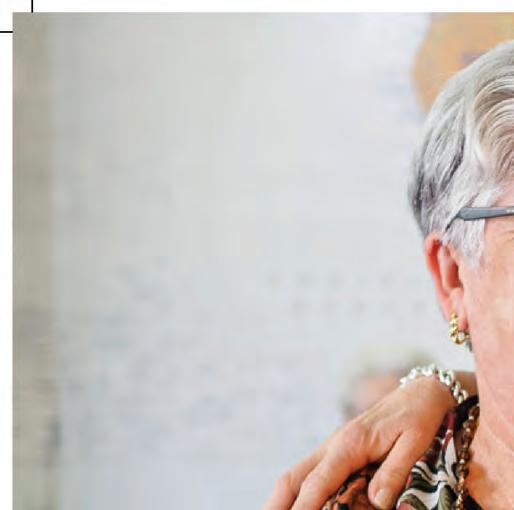
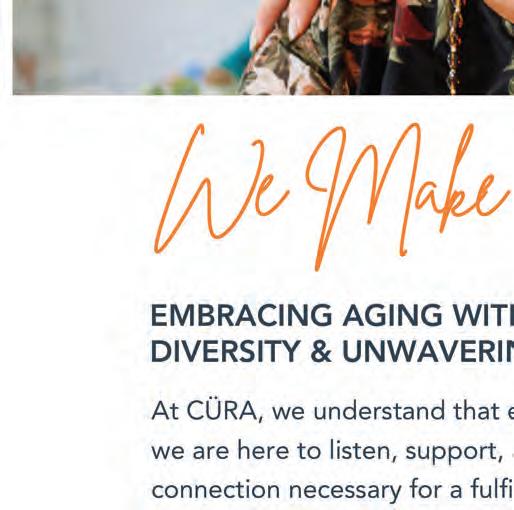
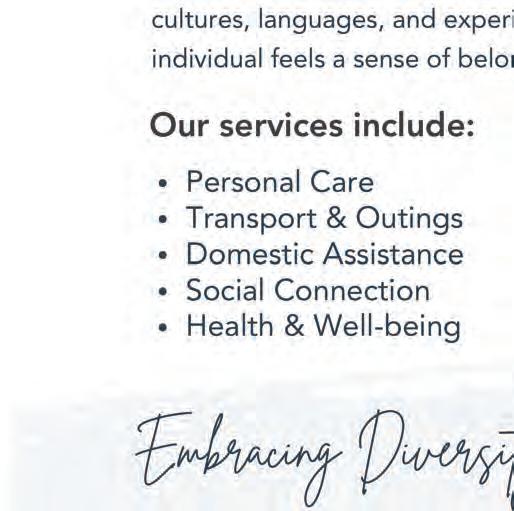
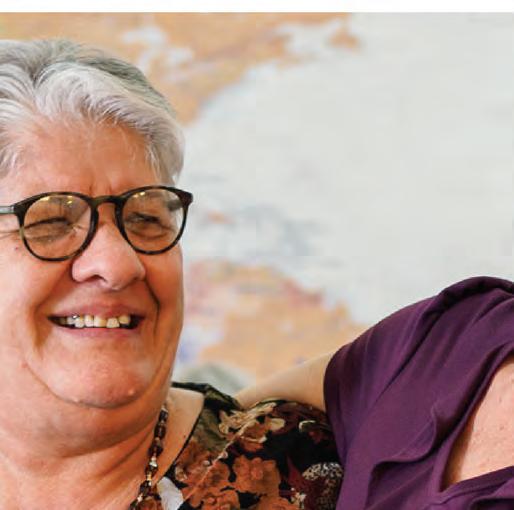
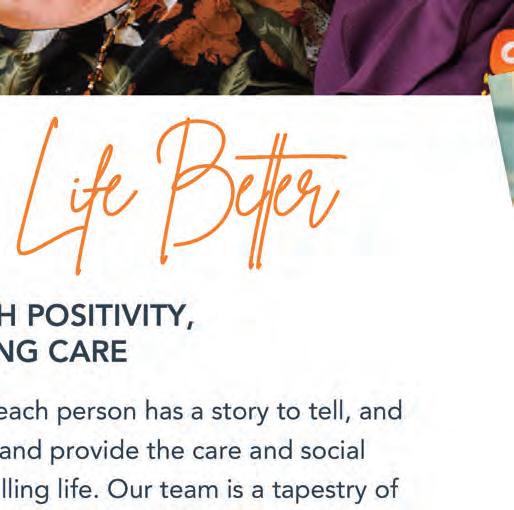
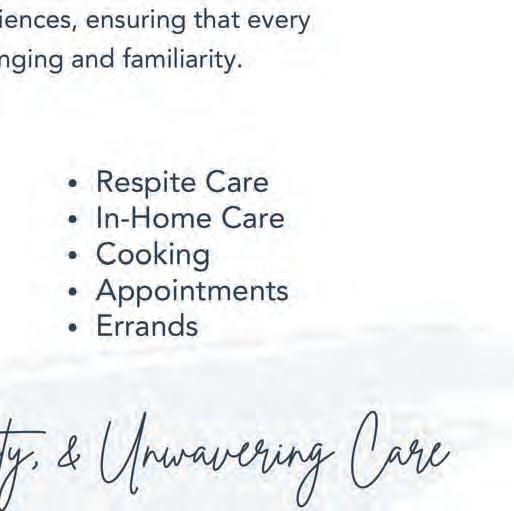

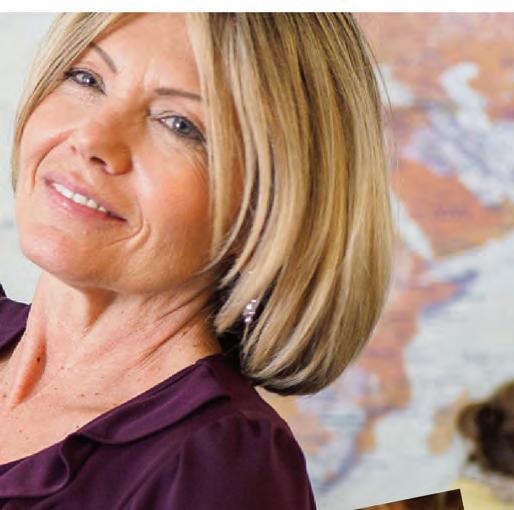
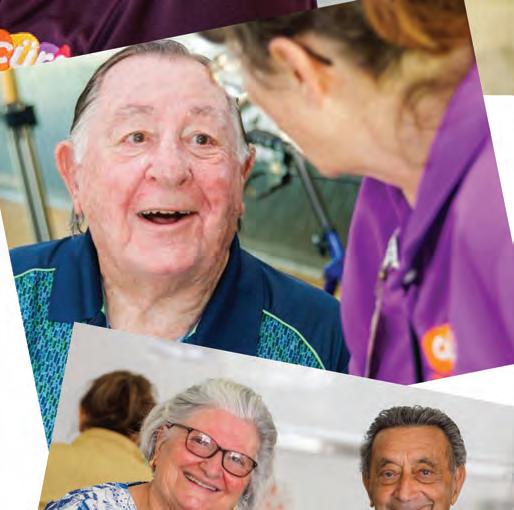




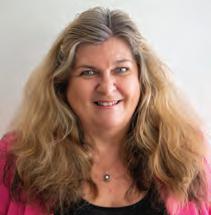
When I was a little girl, watching reruns of Gidget and Elvis movies on the weekends, all I ever wanted to be was 16.
Slicing sand and living the beach life, a la Annette Funicello, seemed idyllic. But six or eight years is a long time to wait when you’re young. Then you’re too busy playing sport, studying and smiling at your blond-haired and blue-eyed crush to notice 16 has been and gone.
On to university and my first job as a country reporter … and I can remember calculating that I would be 38 in the year 2000. Wow! That was old, but luckily that felt like eons away.
Then the new Millennium with its Y2K scaremongering also came and went, with the beach party to end all parties – now with a husband and two primary school-aged sons seeing in midnight. That was 24 years ago!
As John Lennon sang: “Life is what happens to you when you’re busy making other plans”.
These days, however, I try not to look too far ahead. As they say, every day is a gift. That’s why it’s called the present. I am trying to live my best life for today and, in doing so, I have become a ‘yes woman’: saying yes to opportunities to be in the moment for my family, friends, colleagues and neighbours. If not now, when?
That’s a little about me – the new kid on the block, as I take up the Your Time reins as editor. First and foremost, I want to pay tribute to my predecessor Dot Whittington, whom I know has brought sunshine, wisdom, informative features and a variety of voices into your lives through these pages. Please join me in wishing her well as she lives retirement to the fullest.
And from this month, I don’t want you to waste another moment in living your best life, either. So, set aside some ‘me time’ and dive right in to our cover story on Pages 4-5 and a new feature called ‘What’s hip’ on Page 6. Enjoy!
PS. I’d love to hear your feedback and suggestions on topics we should feature in upcoming articles. Email me at shirley@yourtimemagazine.com.au.






SHIRLEY SINCLAIR discovers there’s no set formula for living our best life as we get older, but there are plenty of clues as to how anyone might start on the path to living the life they want.

WITH every orbit the Earth completes around the sun, we can’t help but feel the promise of new beginnings and the possibility of a better life. By March, sadly, most of our resolutions to be shinier, bolder, healthier, fitter and happier have fallen by the wayside.
It was American television personality, talk show host, actress and entrepreneur Oprah Winfrey who famously encouraged her followers to “live your best life” or, in other words, to create the life you want.
And some people seem to be able to live large and strong all-year ’round. How do they do it? Does it get easier over 55 to live their ‘best life’ each and every day?
So, Your Time went on the hunt for the secrets to living life to the fullest.
The Federal Department of Health and Aged Care website talks about positive ageing. Maybe that’s a good place to start.
“As you age, your focus may shift from work and raising a family to planning for retirement and long-term financial security. But it is just as important to plan for your health, aged care and connection to community,” the website states.
“This is known as positive ageing, which can help you stay healthy and independent for longer. Looking after your body and mind can prevent many diseases and help keep you healthy and happy as you age. This involves:
• physical activity and exercise
• food and nutrition
• mental health
• preventative health.”
Life coach and Your Time columnist Charlie Griffiths says the question of “how to live your best life over 55” is all about aligning actions with values.
“Long before I became a life coach, I concluded that it doesn’t matter if you’re 18 or 80: whatever decision you make, make it for the right reason(s),” he says.
“Some decisions are going to turn out great and some will prove to be dumb. As long as you’re comfortable with why you made that decision, you can live quite comfortably with it and defend it.
“My book Runaway Retiree … is all about helping Baby Boomers reconnect with their inimitable ’70s persona and apply that fearlessness and virtue to whatever they decide to do in their 70s.
“The sub-title of the book is: ‘Do your best work in your 70s’. That’s my motto and I can hardly wait to get into it. I’m 69 … so still have a bit of time to practise.”
A Psychology Today (psychologytoday. com) article highlights ‘9 Longevity Habits for a Happy and Healthy Older Age’ from Meg Selig, the author of Changepower! 37 Secrets to Habit Change Success.
She lists the nine habits as: cultivate love, friendship and social connections; become more conscientious; exercise and stay active; cultivate positive beliefs about ageing; seek a purpose for your later years; save for the future; reduce excessive and chronic stress; avoid the top causes of preventable deaths; and create healthy eating and sleeping habits.
Kali Lohman, director and psychologist at Mindful Psychology (mindfulpsychology. com.au ), agrees with these, but with one important addition.
“The thing I would add is the importance of a spiritual connection of
some sort – whether that be through someone’s faith or religion, or through practising meditation, especially mindfulness meditation,” she says.
“There are numerous evidence-based benefits for our mental health and it helps to tick many of the ‘longevity habits’ boxes, such as adding to our connections (when we practise with others) and to finding more meaning, purpose. joy and peace in our lives.”
The sum of all these parts seems to be reducing stress and putting more joy into our lives over 55 to ensure we thrive.
Readers may be familiar with communications and performance expert Amanda Gore’s The Joy Project (thejoy project.com). It aims to create a global joy movement by helping people start mini joy movements with their families, friends or workplaces.
Her book Joy is an Inside Job offers 12 steps to joy: simple but profound exercises that will help eradicate fear in your life and bring much joy and success. Two of the most powerful messages she gives is to do away with FOWOT (fear of what others think) and to practise gratitude – for what we have, who we are, and, in particular, how we got here. Appreciating every event that has happened to get you to this point is using the wisdom we have gained.
“One of my secrets for living my best life after 55 is to not think I’m 55 and that 55 is old,” Amanda says.
“Seriously, I work at keeping my body in good shape (with a power plate and movement), I have paid attention to my diet for most of my life, I learn something new most days and am always curious, grateful and in awe of nature and the world around us.
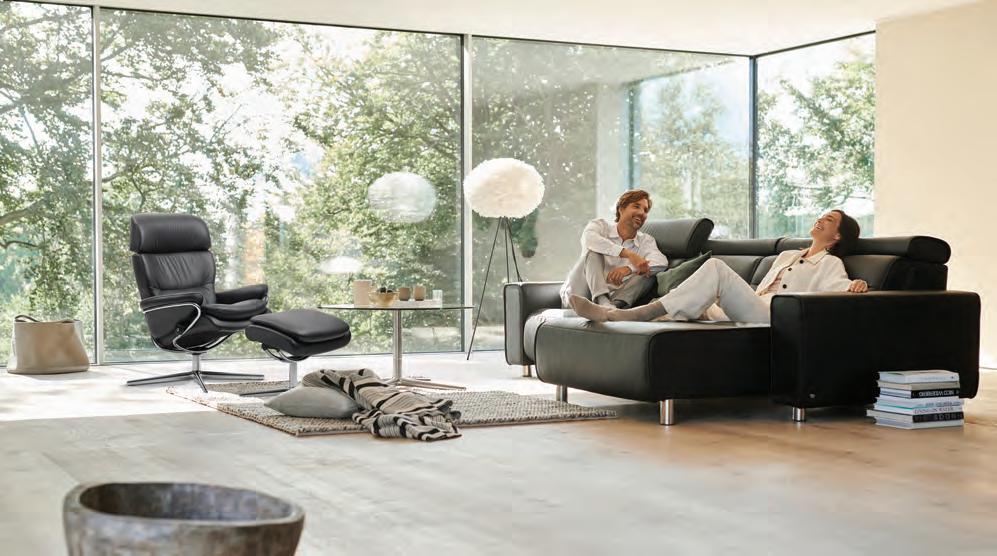








“Although I sound a bit like a space cadet, I think those things and the fact I don’t think ‘old’ mean I am a perpetual 45 year old. And I am 69 now.
“My body is in better shape than most 45 years olds these days. My face gives it away but you can’t have everything. LOL.
“Oh, and a sense of humour makes a huge difference, along with not taking myself too seriously.
“Knowing you are worth loving, learning to love yourself and help yourself feel safe are two key emotional keys to living your best life. These core fears are the most common stories we tell ourselves as children and they become core, unconscious beliefs that rule the rest of our lives.
“You are worth loving and in most situations, you are safe but our childhood beliefs take over. Work on changing those and you are well on the way to your best life. Give your body what it needs to repair and rejuvenate (the right food, sleep and exercise), hang around with young people to remind yourself how to ’think young’.
“Focus on joy, wellness, gratitude, compassion, love and learning and explore your beliefs – and have fun and laugh as often as you can. In short, be joyful. It’s the foundation for your best life.”
Making the decision to try to live our best life isn’t something we necessarily do consciously. Rather, we ‘just do it’. And this ‘good life’ is different for everyone.
For some, it’s a feeling of place: somewhere they’ve always wanted to live, or be closer to family. For a few, it’s about finding love and companionship, gaining a new lease on life. Giving back to the community by volunteering or mentoring, pursuing new skills, being able to travel at a whim, joining a social group ... all of these may come into play.
When we’re in the middle of it, we may reflect on the fact with a smile or chuckle.
These folk reckon they’re pretty darn close to living their best lives right now.
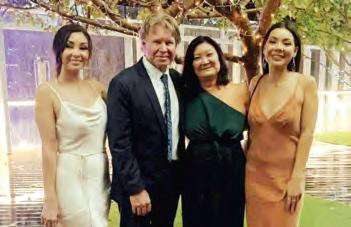
Name: Jim Graham.
Age: 62.
Work status: Self-employed electrical fitter.
How do you try to live life to the fullest?: I’m definitely a glass-half-full kind of guy. Working for myself over the years has given me loads of time to reflect on life and how lucky I am to have it. At the age of 25, I was diagnosed with a pretty nasty cancer. With a young wife and an unclear prognosis, I was in, at times, worrying and unchartered waters. But here I am now, 41 years married to my beautiful wife Linda, and have two gorgeous daughters Caity and Kristy and I’m still livin’ and lovin’ life.
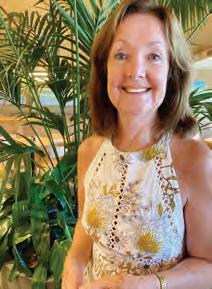
Name: Sylvia Reid.
Age: 74.
Work status: Retired administration officer.
How do you try to live life to the fullest?:
By being active, helping out at my grandchildren’s school, and giving back to the community. At the moment, I’m helping an elderly neighbour who had a stroke. I like to always be positive and upbeat, and I’ve taken up playing the ukelele (I’d never played an instrument in my life until now!).

Name: Mick Dickfos.
Age: 64.
Work status: National plant hire manager.
How do you try to live life to the fullest?: We have been planning for a move to the Sunny Coast and a gradual transition to retirement. This is now happening later this year. Life, for me, is spending time with my sweetheart wife Kate. We are very modest in what we need to be happy. We have an old Ford Transit van comfortably decked out for travelling. I love spending time with family and am very fortunate to have amazing friends in my life. Life is great and I’m so grateful.
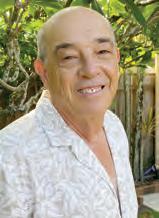
Name: Angelo Harrison.
Age: 68.
Work status: Retired businessman. How do you try to live life to the fullest?: I try to live my best life every day, with the help of my wife, children and grandchildren. I try never to be a ‘glass-half-empty’ kind of guy, and my friends help me to remain grounded and positive. I believe that everybody has a story to tell, and being interested in others keeps me excited in life.
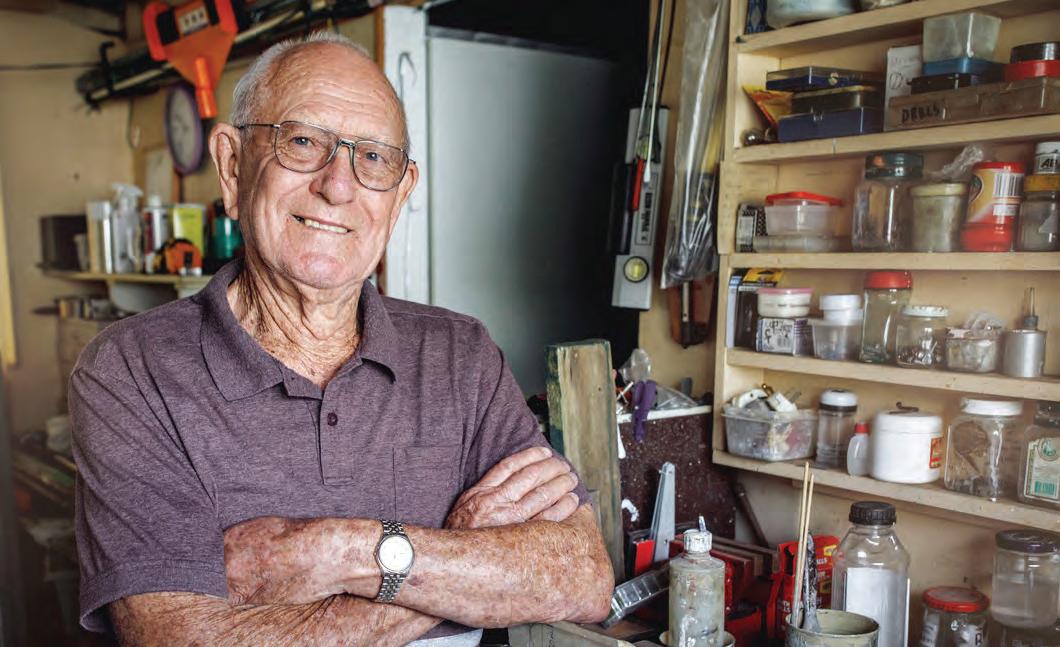
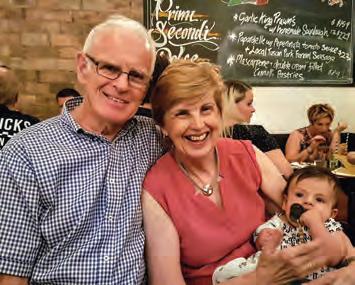
Name: Lyn Brooke.
Age: 78.
Work status: Retired administration officer and receptionist.
How do you try to live life to the fullest?: I’m now enjoying time with husband Phil, family and friends, but it took a while to adjust after working until late in life. I have been very blessed with four children, seven grandchildren and a marriage of 57 years. I love travelling domestically and overseas, doing patchwork, reading and babysitting.

Name: Helen Heaton.
Age: 62.
Work
Status: Retired. Former long-haul Qantas flight attendant.
How do you try to live life to the fullest?: After 30 years of flying around the world, there’s nothing quite like stopping and discovering paradise is right here at the beach in your own backyard. I cram plenty into my days, nurturing and learning from my immediate natural environment, our greenbelt, my garden and my birds, which in return generously enrich my life.
No, not the replacement surgery kind of ‘hip’. It’s a selection of on-trend snippets that could include places to dine, travel destinations, where to shop, what to see and visit, as well as what to watch, read and listen to, so you can stay up to date with family, friends and neighbours of all ages.

McCartney 321 on Disney+ (and recently on ABC iview) is a six-part series featuring one of the greatest songwriters of our time chatting with American producer Rick Rubin on sound desk. Rubin dissects Paul McCartney’s career, the tunes, the songwriting process, the studio atmosphere where magic happened, and other juicy titbits you never knew. The soundtrack of our lives is ever-present, along with rare footage and nostalgic photographs of The Beatles.

The Thursday Murder Club books by Richard Osman is an intriguing whodunnit series. It starts with the book of the same name and is set in a peaceful retirement community in southeastern England, where four friends meet each week to discuss unsolved crimes as a bit of harmless fun to keep their minds active. That’s until a local developer is found murdered and in possession of a mysterious photograph, forcing them to combine their diverse range of career and life skills to try to solve the murder … before more bodies start piling up.

Pink Floyd’s The Dark Side Of The Moon masterpiece album, originally released in March 1973, has turned 50, and the Brisbane Planetarium is celebrating with an immersive experience. With the help of modern technology, the show combines breathtaking views of the solar system and beyond, played out to 42 minutes of The Dark Side Of The Moon in surround sound. Go to brisbane. qld.gov.au/whats-on-in-brisbane and search for ‘Dark Side of the Moon’.

When was the last time you enriched your life at a show at QPAC at South Bank? Take your pick from the wide-ranging program for March. Tempt your inner foodie with An Evening with Nigella Lawson (March 14, 7.30pm at the Concert Hall). Maybe you’d like to fill your hearts with the a capella brilliance of The King’s Singers (March 20, 7.30pm at the Concert Hall) or perhaps join physicist and bestselling author Brian Greene’s multimedia journey across the cosmos (March 20, 7.30pm, at the Playhouse). Visit qpac.com.au. Meanwhile on the Sunshine Coast, The Station opened on March 1 on the former NightQuarter site at Birtinya, promising more of the same all-ages food van dining, bars, live music and relaxed social gatherings. See thestationsc.com.au.

Endless Summer was a groundbreaking surf film that achieved cult status and this year celebrates 60 years since its first cinema screenings in 1964. Today’s ‘surf-and-travel’ culture and the pursuit of perfect, uncrowded waves owe their origins to sell-out screenings at the height of a snowy winter in Wichita, Kansas, when filmmaker Bruce Brown and business partner R. Paul Allen took over the Sunset Theater for two weeks, and outgrossed My Fair Lady
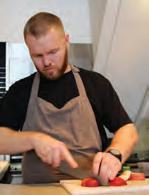

They’re more than 120km apart but they share a common attribute: Mapleton Public House and Clarence Restaurant, Woolloongabba (pictured), put as much care and attention into the treatment of veges as any protein in their paddock-toplate experiences. Book at mapleton. pub or clarencerestaurant.com.
Even if you haven’t the energy to enter the Mooloolaba Triathlon – the world’s second-biggest triathlon festival, to be held this year from March 9 and 10 – see the athletes of all ages, abilities, shapes and sizes who really know how to put on a show in this spectacular sun, surf and sand arena. Keep in mind the chance to volunteer and tri the fun your way. Go to mooloolabatri.com.au.

LIKE taxis before them, Uber has revealed plans to launch a phone hotline as part of a new service designed to get more seniors on board.
Uber has revealed plans to launch a phone-booking ride service in what its top Australian executive admits is “a bit of a back-to-the-future moment”.
The tech giant launched its ride hotline in a bid to appeal to Australians over 65 who do not use ride-sharing services and prefer to book transport over the phone. Uber’s new service comes less than a year after the company launched a similar scheme in the US, and has been welcomed by a seniors’ advocacy group.
Uber Australia and New Zealand managing director Dom Taylor says the company identified that some older Australians are not using the service because they are not confident in navigating its app. The launch of a phone-booking service could feel like a throwback to the days of ordering taxis before Uber’s 2012 launch, he says, but encourages more people try the service.
“It’s a bit of a back-to-the-future moment for us,” he says. “There are groups within the community that are less open to using apps for a number of reasons and we
can still use our core product to help them move around.”
The new 13-UBER service, available between 5am and 8pm, will allow users book a ride over the phone, or set up an Uber account for the first time. Users must have a mobile phone to receive a text message with ride details, and will receive a second text message when their driver arrives at their pick-up location.
Mr Taylor says research conducted by YouGov showed 93 per cent of Australians aged 65 and over felt more confident booking services over the phone, and hoped the hotline could provide a new transport option for them.
“We have seen in the US it is a source of new riders coming to the platform who are less comfortable with apps,” he says.
“We know that older Aussies have a lot of appointments and that they are a very social group of people who are still going out for dinners and to the movies.”
National Seniors Australia chief executive Chris Grice welcomes the move to make the service more accessible, and hopes it will help seniors with specific challenges, such as mobility issues.
“Not everyone is able or comfortable using apps because of privacy, security and storage concerns,” he says. “It’s an interesting reflection of society, but a good one, when we welcomed being able to make a phone call and speak with a person to book a service.”

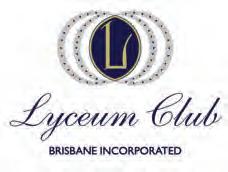

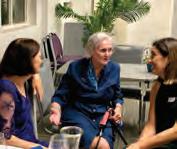


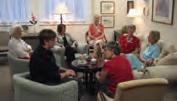


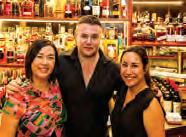



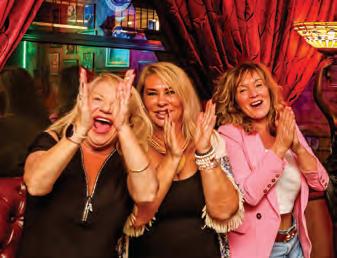

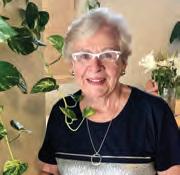
EVER watched a small child sitting on a high-chair dangling their feet?
The usual reaction from parents is: “Hold your feet still”.
The feet keep on dangling.
They kick the chair and the whole scene ends up in angry words and tears.
Have you ever tried to sit with your feet dangling in the air?
Remember the old barstools without a footrest and how you had to shift and wriggle because you were uncomfortable? I remember.
I can still feel what it was like when your feet were all pins and needles and there was nowhere to rest them.
Many times, I have intervened, trying to explain why the child with the dangling feet won’t sit still.
The result is that we are both in trouble.
Then there is the ice cream episode. It is a very hot day and mother buys an ice-cream for her little one.
It doesn’t take long and the child will ask for a drink.
He or she is roused on: “Don’t be greedy. After all, you just had an ice cream.”
My heart immediately goes out to the child. I can never eat an ice cream without feeling terribly thirsty afterwards. I, of course, can buy a drink anytime.
Ever had to wear a scratchy jumper that feels like a hairshirt of old?
Even pure wool can be torture on sensitive skin. Now, I would put it straight into the op shop pile.
Ever faced a meal when your stomach is tightly closed, with a giant standing beside you, trying to force you to eat those hated Brussels sprouts? “Eat those Brussels sprouts, or else!”
I know, I know. Leave Johnny to his own self and he would probably live on ice cream, cheese sticks and sugary soft drinks. Of course, I can say “no” to any meal I don’t want.
Where teenage years are concerned, I think I understand them.
I was the proverbial, rebellious girl. Didn’t I absolutely adore Elvis? Didn’t I love James

Dean until death. Didn’t I tighten my belt until my waist cracked and my mother declared I would never be able to have normal children with such a ruined body?
Didn’t I simply have to dress in multicoloured socks or be forever shamed in the eyes of my friends?
I still remember it as if it happened yesterday.
I feel like quoting the famous song from an old movie: “Oh, I remember it well.” My heart is on the side of the teenager.
Of course, I know my duty. I make an earnest face and preach the right behaviour to my greatgrandchildren (the grandchildren are all adults now), but somehow it always sounds wrong.
The adults sigh and the children don’t take me seriously.
I am a bad influence on youngsters because my youth is still so vividly alive in me.
I was lucky. I had a mother and father who understood that not eating Brussels sprouts was not the end of the world. While they gave me boundaries, they also understood my dreams, the hassles of growing up and learning to deal with life.
May you remember a happy childhood … and tolerant parents.
Email mocco.wollert@bigpond.com

TWO-year-olds must be the funniest people on the planet.
Professional comedians with scripted material and hours of practice are entertaining, but tiny tots have the ability to bring a laugh without even trying. It’s that age where they mimic actions and words, making us careful of what we say within earshot.
They may be pint-sized, but their brains are like sponges. My son likes to teach his daughter ridiculously, long words and she will repeat them like a parrot. I’m sure ‘onomatopoeia’ will come in useful for her one day. Two of my granddaughters (pictured) are this age and they both crack me up with their comments and actions.
One has a baby sister, which probably explains why she often ‘breast feeds’ her stuffed toys.
There is no explanation for the recent photo my daughter sent of said child sitting on her potty upon the coffee table in the lounge room and staring wistfully out of the window. The caption simply said, “I don’t know” – as if answering the obvious question of ‘why?’.
I love the way she sings “Daisy, Daisy, give me your answer do” on an endless loop – mostly with the wrong words, but the tune is there.
When explaining the word ‘enormous’, I pointed

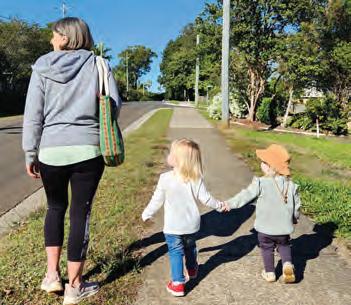
to some rocks and said, “They are enormous!” She shook her blonde curls and simply stated: “No, they are rocks.”
The other granddaughter is just as straightforward with her opinion.
When I gave her a glass of water with lunch, she said with a sigh, “I just like San Pellegrino.” This one also commented that her great grandma was dead … just like dinosaurs and mammoths.
They both break into infectious giggles when I make their toys ‘talk’, or feign sleep so they can wake me up by jumping on me.
Equal enthusiasm goes into a tantrum. Kids this age should come with a warning label about the possibility of going from sweet angel to spawn of the devil in a very short time. These meltdowns are caused by such horrors as wanting to wear a different T-shirt to the one suggested or not wanting butter on a scone. Home-based
tantrums are one thing, but in public places, they can be quite terrifying.
Two-year-olds are fiercely independent and believe they can do everything themselves – everything from dressing themselves in back-to-front clothes to trying to put two legs in the same leg hole of their shorts, often falling over as a result.
(Without wanting to incriminate myself, it’s also possible to do this at 60.)
They insist on emptying their own potties. As they carefully transport a sloshing potty to the toilet, one can only pray they will make it without spilling the contents. When they help wash the dishes, the kitchen floor gets a good wash at the same time. Many things take longer than they should. They want to buckle their own seatbelts and no matter how late you might be, will refuse your help.
They would rather walk than sit in a stroller, so the trip to the local park is the slowest amble you’ll ever have. When they tire, they’ll want to be carried and you’ll wonder when they got so heavy.
The best part about grandchildren is that it’s like having a little piece of my own children’s early years back again. It’s also nice to see my own offspring turning into capable parents. Maybe, just maybe, their father and I did something right.
We all know it’s gone in the blink of an eye. I’ll just enjoy the wisdom of two-yearolds while I can.
Visit lockwoodfreelance.com
EVERY 33 minutes, a life is turned upside down by epilepsy: a neurological condition that can affect anyone at any time.
This month, Queenslanders will join footballing legend Wally Lewis (pictured) to turn the nation purple and change lives.
“I wish I’d opened up about my condition to my friends and teammates, instead of keeping it to myself,” the sports commentator says. “If I had one wish for Make March Purple, it would be that it helps people with epilepsy to feel less alone, because when you aren’t afraid to be open and honest about your experiences, it’s so much easier to access support and

GRIFFITH University is part of a transdisciplinary consortium to develop and commercialise revolutionary and life-changing implantable cardiac devices.
The Medical Research Future Fund grant will be used towards developing and commercialising three key devices to treat the most-common forms of heart failure.
Associate Professor Michael Simmonds, from Griffith’s Mechanobiology Research Laboratory, leads a team that has worked collaboratively with biomedical company BiVACOR, providing expertise that has been critical towards the regulatory approval of the devices and to ensure
they’re blood friendly. “One of these devices is a complete artificial heart that has all the functions of a native heart which is revolutionary, while the other two technologies offer different approaches to support a failing heart,” he says.
“All three devices use technologies that will allow them to mimic a natural heart by automatically responding to the body’s physical demands, for the first-time offering those with heart failure a pathway to staying active ... this is a game changer for those with advanced heart failure who are typically bed-bound by enabling them to return to relatively normal living.”
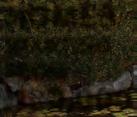
overcome whatever hurdles you’re encountering.”
Epilepsy Queensland CEO Chris Dougherty says that public awareness is critical in helping people navigate the central nervous system disorder. Join Epilepsy Queensland to Make March Purple in 2024, by getting purple ‘mucked’, turning your profile picture upside down on social media and sharing your epilepsy story.
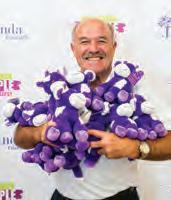
Visit makemarchpurple.org.au





www.jetagardens.com

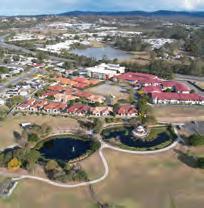

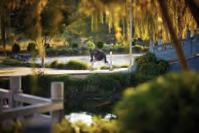

It was always fun and games when the circus came to town, but the animals certainly stole the show, as LYNDA SCOTT reports stay indoors, while armed guards patrolled the streets.
They called it the greatest show on Earth … and the elephants were the stars.
When Wirths’ Circus came to Brisbane, the elephants were the centre of attention, even before the big top went up.
In the 1950s, the circus travelled with its own train, and “half the children of Brisbane” reportedly turned out when it arrived at Roma Street.
This 1953 photo (right) from the Royal Historical Society of Queensland archives shows much-loved Dolly unloading and skilfully manoeuvring wagons at the railway goods yard.
Then came the spectacle of Dolly and her mates towing everything across the Victoria Bridge to Lang Park, where Suncorp Stadium now stands.
Wirths’ Circus was Australia’s largest and most prestigious, touring from 1880. It was billed as our own ‘greatest show on Earth’ with exotic performing animals such as elephants, lions and monkeys.
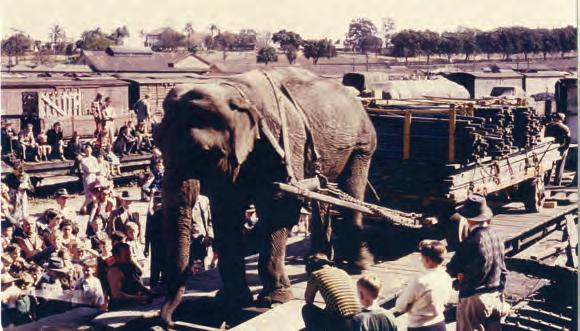
The arrival of the circus in town was often heralded by news of an ‘escaped’ animal, which caused much excitement.
Cynical journalists believed it was an attempt by the operators to drum up free publicity, but it always made a good story.
That was the case two years earlier in Brisbane. Jessie the elephant went on ‘walkabout’ after her evening bath at Lang Park. Newspapers reported that she trundled along the Milton tramline, headed for town, before
being apprehended near the police barracks in Petrie Terrace.
Two months earlier at Coffs Harbour, five lions and an elephant escaped in what appeared to be a genuine accident. The elephant was drawing a cage containing the lions over a crossing to the railway station. A shunting goods train crashed into the cage, smashing it and freeing the lions. The elephant took off, adding to the chaos.
Residents were warned to
In the 1920s, during a Brisbane performance, an elephant reportedly became ‘bad tempered’ and savaged its trainer.
It was condemned to death and a ‘local big game hunter and policeman’ was called on to put the animal down.
What followed was a shocking public spectacle.
Hundreds of Brisbane residents followed the procession as its keeper rode the elephant across Victoria Bridge to an Enoggera paddock for the execution.
The elephant’s bones were sent to the Queensland Museum.
In another incident, a member of the Wirth family recalled an engineer on a steamer from Sydney to Brisbane filling an orange with cayenne pepper and throwing it towards Toby, the biggest of the herd.
The keepers were mystified as the startled elephant’s cry set off the other elephants, and the
lions, tigers and dogs let out terrible shrieks.
All became clear two weeks later when the circus was returning to Sydney on the same boat. Toby picked up the engineer in its trunk and tried to hurl him overboard. He was saved, just in time, and confessed.
Of course, in recent times, concern about the welfare of the creatures has made animal performances a thing of the past.
In 2007, the last performing circus elephant retired, following an incident resulting in the death of her handler, and there are no more circuses in Australia with exotic animals.
As for Wirths, the circus went into decline with the introduction of television and rising transport costs.
The circus finally closed in 1963 when its headquarters were destroyed by fire.
Lynda Scott is a volunteer at the Royal Historical Society of Queensland. Visit queenslandhistory.org














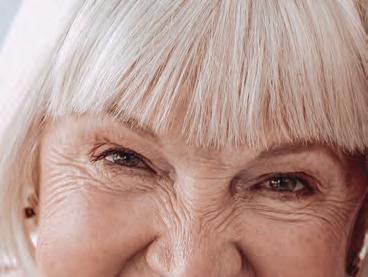




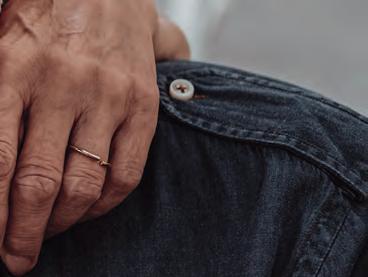






“Everyone

In the ‘Jeopardy’ of life, we may think we have all the answers, but CHARLIE GRIFFITHS believes we should all be asking ourselves one simple question.
Sometimes as a coach, I feel like Arthur Dent in Douglas Adams’ classic tale, The Hitchhiker’s Guide to the Galaxy (pictured)
Arthur is swept up in the universal quest to find the ultimate answer to life, the universe and everything.
The supercomputer Deep Thought, after a period of 7.5 million years, declares the answer to life, the universe and everything to be ‘42’. The computer then has to design a more powerful organic computer, called Earth, to find the question to which 42 is the answer.
I live with inflammatory bowel disease (IBD) and atrial fibrillation (AF): two debilitating conditions with a complex diagnosis and experimental treatment process.
For years, I have been pinning my hopes on a ‘42’ solution, which of course is fanciful. So, with an introspective mindset, I decided to look deeper.
Even if the answer is 42 (some magic drug or treatment), what is the question?
In other words, my chronic diseases are physical challenges, but I have choices.
I can give up and let them take their

rather unpleasant toll. I can put up with the discomfort and live a mediocre life.
My comfort zone doesn’t need to be stretched because I have an excellent excuse to not try too hard.
I can stand up and say, “This is what I want to do and achieve in my life!” and just bloody do it.
So, ‘the question’ is: what do I want to do and achieve in my life?
I want to be a coach and help people live the best possible version of themselves. But effective coaches need a niche.
I need to define a demographic I can relate to, and one that is willing to do whatever it takes to get the results they and their loved ones deserve.
The niching process involves identifying ‘pain points’ that potential clients need solutions to.
To do this properly, I learned that I had to pick painful experiences that I have survived.
My list included all manner of nasty stuff such as nursing my sanity through a bitter divorce, a multitude of career changes, and an extended mid-life crisis.
My ‘42 moment’ came when, with biro in mouth and fingers tapping on the desk, the title of my list jumped out and slapped me in the face.
It read: “Pain points”.
I extracted suppressed memories of life-saving surgeries to remove a gangrenous gall bladder and a Hartman’s procedure to remove a large section of bowel after a diverticular perforation.
Then there’s my ongoing IBD and AF. I know about this sh*t, and I’m prepared to draw on my experiences to help others in similar situations.
This is the first time I have publicly spoken about my little medical problems.
I can’t change the past and it’s not something I want to relive.
We recently lived in a caravan park

where conversations with grey nomads invariably turned to medical issues, drugs and beloved doctors. When it became a competition, I would change the subject or just leave. If I wanted, I only had to lift my T-shirt to end the discussion.
So, my career path is now settled. At the age of 69, chronic diseases, scars and all, I am available to work with middleaged professionals struggling with career decisions after being diagnosed with a chronic disease.
More than a worthy cause, this is a worthwhile enterprise through which I will not just survive but thrive well into my seventies and beyond.
What’s your plan?
If this article resonates with you, I would love to hear from you. Contact me at charliegriffithscoaching.com.

Charlie Griffiths is
Neuro Linguistic Programming practitioner dedicated to helping fellow baby boomers achieve their full potential.









An obligation-free appointment with our aged care advisor to help navigate you through the process.
Aged
We liaise with facilities to organise your move from home or hospital and complete all the necessary paperwork.
Centrelink Service
We will handle all your

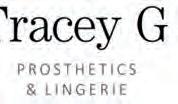
We enjoy meeting with clients to fully understand your goals and objectives, and working together to find the best outcome for now through to estate planning, ensuring peace of mind and comfort with your financial future.
We look forward to helping you navigate through the next stage of your life.
RV

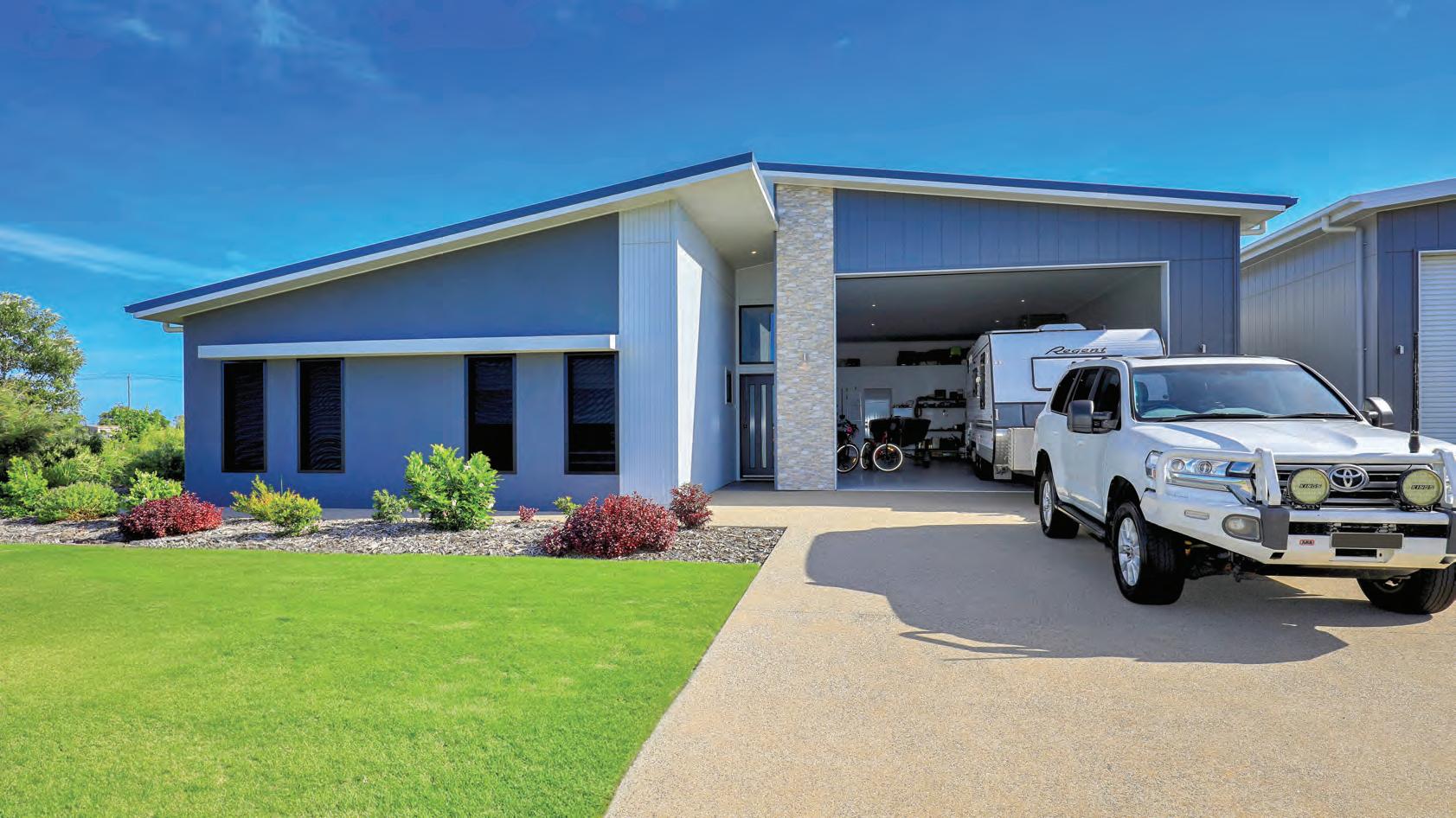



Luxury
designed homes
Oversized RV garages in every home
Premium facilities
Pet friendly community
No entry or exit fees, and no stamp duty
Retain your capital gain
TRISTAN HALL looks at simple steps everyone can take towards a healthier and happier life.
To start 2024, the allied health team has decided to provide the ‘fast fours in ’24’ in relation to a few subjects within our scope of practice as exercise physiologists and dietitians.
The four pillars of health (as we see it) are: activity; nutrition; sleep; and environment.
Activity and exercise – Our bodies are designed to move. It has a ‘use it or lost it’ mantra, or ‘motion is lotion’ is one of our favourites. Our physical fitness and capabilities will hold the threshold to what we can do regularly. Moving more may seem fatiguing, but it’s actually a signal for the body to provide more energy to handle the stimulus. It is the best way to help your body excel at the normal daily demands and handle the extra activities we want to be involved with. The biggest take-home tip? Do something you enjoy. Positive feedback is the best motivator.
Nutrition and hydration – Your food and, by extension, fluid intake provide the energy, biochemicals and nutrients for the body to utilise. What you eat essentially wires your

body and cells for you to think clearly, function optimally and provide energy to move. When cells and systems are lacking energy and nutrients, this stress can negatively impact metabolism and increase inflammation circulating. Your body needs the building blocks to regularly renew and rebuild.
Sleep and recovery – This is your biological tool to ‘be better’ for the next day and arguably is the most load-bearing pillar. It only takes a few nights of poor sleep to affect our physiology. While you might be able to continue with tasks, stress hormones and survival mechanisms are already active. A big driver of injuries, pain and mental health

issues is not necessarily from overdoing it, but rather from under-recovering.
Environmental – The environment you choose to be in can be broken into many cohorts. However, we like to focus on our physical and social environment as major contributors to our overall wellbeing. Physically, with more happening inside homes, shops and workplaces, we begin to lack exposure to full-spectrum light, fresh air and time in nature. Spending time outside sends signals that help regulate many, if not all systems. In a social sense, surrounding ourselves with people and communities that we can connect to is an integral part of life fulfilment. More so quality, not quantity. By choosing our environments carefully and reducing internal and external stressors, we can assist with regulation of our energy levels.
Tristan Hall is an exercise physiologist at Full Circle Wellness. Call 0431 192 284 or visit fullcirclewellness.com.au
DISTRACTION is an effective method of pain management.
Who is ever 100 per cent pain-free?
A very good way to achieve distraction with certain injuries and conditions is to exercise.
Exercise is a method often prescribed by medical professionals as a complement to medications and rehabilitation. The main reason distraction works is due to endorphins.
Endorphins are released from the pituitary gland, and they can actually block pain, depress appetite, create a felling of euphoria and reduce tension and anxiety.
Exercising is particularly beneficial in terms of endorphin release. Blood levels of endorphins increase above resting levels up to five times, with longer-duration (over 30 minutes) aerobic exercise at moderate-tointense levels. An increased sensitivity to endorphins is
developed after several months of regular exercise.
Endorphin release tends to be an individual response, although it is usually associated with longerduration exercise. Often, you may feel stiff and sore when you wake, but after a few minutes of exercise and movement, the pain seems to be less. The combination of endorphins and distraction may have a lot to do with the pain seemingly stopping or at least reducing.
Of course, there could be many explanations for that, including the fact that blood flow around the painful area is bringing more oxygen to the site. If you enjoy exercise with a friend, the conversations you have during your session also helps you focus on something other than your own pain or discomfort.
Tom Law is the author of Tom’s Law Fit Happens. Visit tomslaw.com.au





Forover50years,wehavebeenprovidingthein-homesupportyou needtoliveindependentlyinyourhomeandenjoyyourcommunity. Wedesignourservicestosuityourneeds,fromeverydayservicesor justoccasionalhelpwhenyouneedit.Ourservicesinclude:
In-homepersonalcare
Preparationanddeliveryofmeals
Transportservices
Socialsupport
Respiteservices
CommunityCentresandoutings
Wellnessprograms

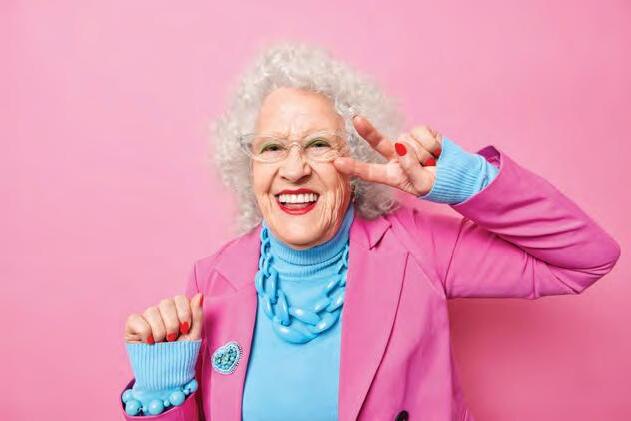
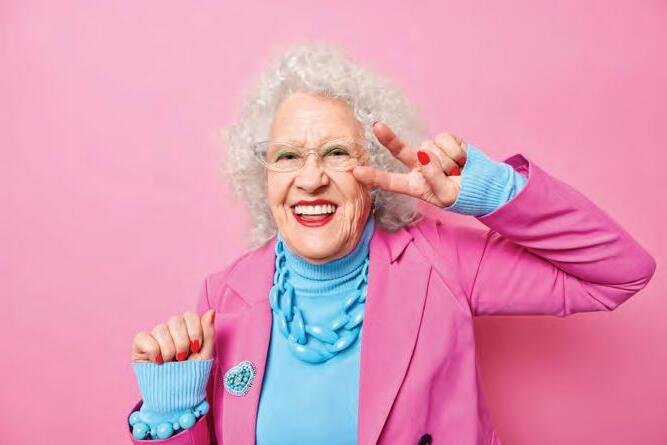
HomeCarepackagemanagement
Housekeepinganddomesticassistance
HomeandGardenmaintenence
NDISCoordinationservices
AlliedHealthcare
Nursingservices.
Lookingafteryourcommunitysince1970. SuncareCommunityServicesisaregisteredNotForProfitorganisation.









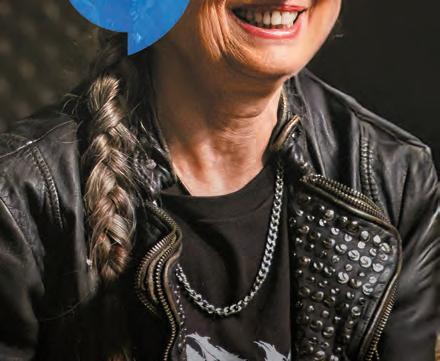
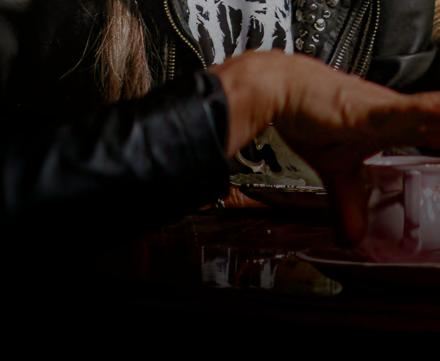
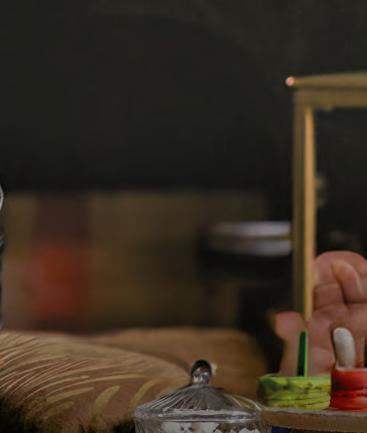


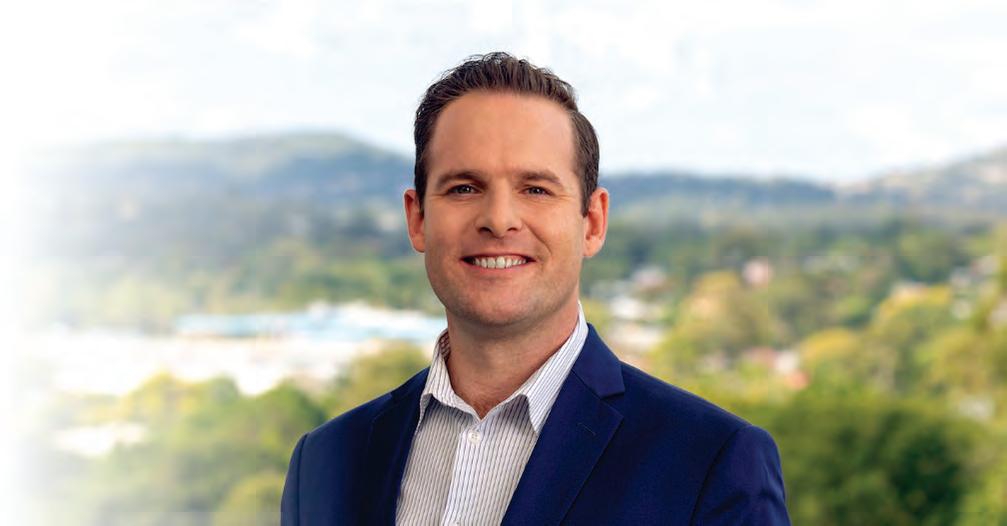
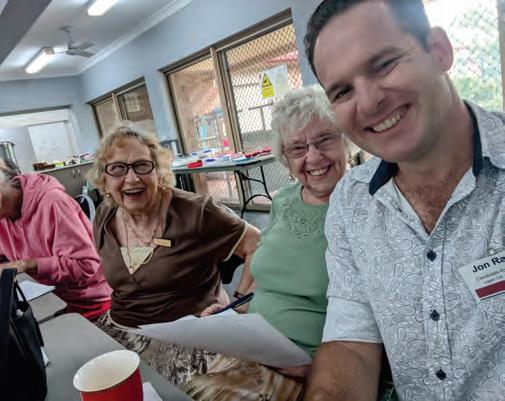

My name is Jon Raven and I would love to be your next Mayor of Logan. I live in Waterford West with my fiancé Alison, two teenage kids and way too many pets! I have worked for the residents of Division 5 as their Councillor for the last eight years, including two years as Deputy Mayor. Before I was elected, I owned and operated an asbestos safety and demolition business.
Election Day 16 March 2024
Leaders should be active when disaster strikes - I have been in the past and I will continue to be as Mayor. When the storms came on Christmas night I hit the ground on Boxing Day and started helping. The people in the south of our city did so much to help themselves, but I made sure I was there at the Jimboomba Community Hub every day to support locals with grants, volunteers and Council services until power was restored.
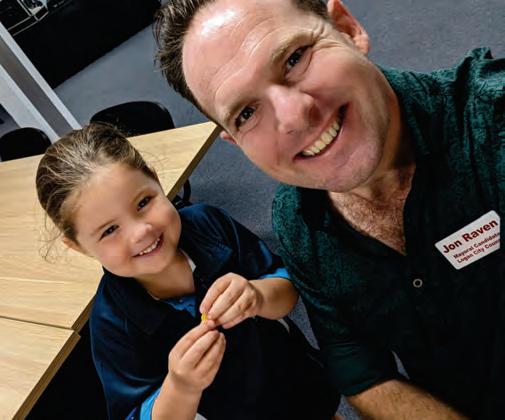

I want our city to be affordable. As Mayor I will support offering discounts on pet registration when you register your pets for 3 or 5 year period, as well as a one-off ‘seniors’registration for pets that are getting long in the tooth. These commonsense changes will save residents money and save Council time in following up registrations every year.
Visit my website to see other ways I want to support locals.

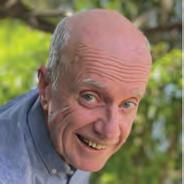
Bouncing into a new era of life, retiree GARRY REYNOLDS shares his thoughts on the world around us.
WHO would have thought dressing like an old-style grandfather could be so cool.
Vogue says the latest look for trendsetters such as Harry Styles (pictured) is ‘eclectic grandpa’.
The fashionistas of the magazine reckon the 2024 look for young men and women is all about colourful knitwear with baseball caps, loafers or sensible sneakers and patterned boxers, all teamed with tweed.
The understated look relies on pieces meant to last decades, if not a lifetime, that have followed their ageing owner’s reluctance to jettison them.
Still, one of the best places to find classic grandpa clothes is in opportunity shops.
The style’s charm lies in the items’ simplicity and comfort while creating a

subtle fashion statement of practical chic.
Eclectic grandpa is what Pop always felt comfortable wearing, despite the protestations of his wife and children who could detect the vague aroma of mothballs when they hugged him lovingly.
Conservative grandfathers are able to dress this way because they purchased high-quality goods made from natural fibres with longevity, rather than cheap garments filled with artificial threads destined to end up in a landfill after a few wears.
Vogue concludes: “What we can really learn from our elders isn’t how to produce a lower-quality copy of their clothing, but how to cultivate personal style through well-loved pieces that will last a lifetime – hopefully, long enough to pass down to our own grandchildren.”
As a grandpa, I might go digging into the back of my old wooden wardrobe to set the fashion world ablaze.
OVER the years, International Women’s Day (March 8) has celebrated the social, economic and cultural achievements of women and grown into a global movement for their rights and gender equality.
Here’s to Life (H2L) extends heartfelt appreciation to the remarkable women within the H2L family. These women have left indelible marks on society and the community through their diverse contributions. They have led rich and varied lives, impacting other women and young women in meaningful ways. The H2L team is dedicated to cultivating a safe and nurturing environment for members to participate in the array of activities offered. H2L has built a supportive community and network where women can share experiences, mentor each other, and access resources and opportunities that support and empower them.
Call Renee at 0408 717 342, email admin@herestolife.org.au or visit herestolife.org.au
FOR more than 100 years, the Lyceum Club Brisbane Inc. has been a place where women come together to discuss and develop their interests. The club provides a friendly, welcoming environment in the Brisbane CBD, just a short walk from rail and bus services – especially convenient
for travellers from the Sunshine Coast, Gold Coast and Redlands. Members and visitors can head along to any of the 15 specific interest groups held during the day. Examples are: music, books, poetry, cinema, mahjong, theatre and art and, in the evening, French and Evening Circle. To continue life-long-learning, two guest speaker forums are held monthly. Special evening events are held during the year.
See the Lyceum Club Brisbane Inc. Facebook page and website or email secretary@lyceumbrisbane.org.au/ membership
ARANA VIEW Club president Hilary Shaw says this year is the ideal time to join, with social events on the calendar and guest speakers booked in. The events and activities are a way to raise funds through The Smith Family to support the education of children and young people experiencing disadvantage. Arana VIEW Club supports 14 students. The club looks forward to welcoming new faces at the next monthly meeting which is on the first Wednesday of the month at 10.30 for an 11am start at Arana Leagues Club in Dawson Parade, Grovelly. A two-course lunch is provided for $35, including tea and coffee. Anyone seeking to become a member can call Carol on 3355 5349 by noon on the Thursday before the meeting.
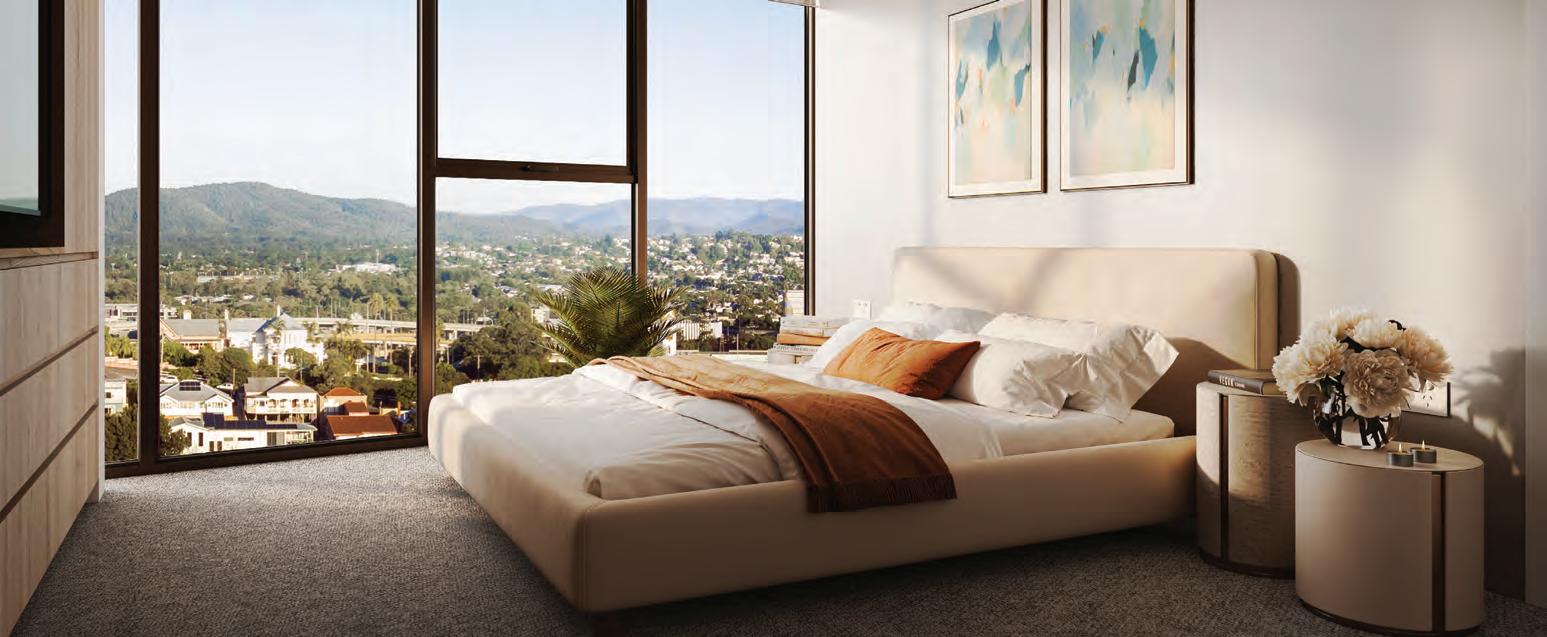
Passwords can be the bane of our existence but EDIN READ explains how to make modern online life easier in remembering and keeping them safe.
With the growing number of accounts we use on our phones, computers and even TVs, there’s one thing that always seems to be an issue: passwords.
We sign up to new accounts, telling ourselves the lie that we’ll remember them and the next time we go to log in, it’s ‘access denied’. In addition to not remembering them, it’s a case of not being sure which password is for which account.
I founded Greyology over two years ago, and passwords has been a continual issue for most clients ever since. After much deliberation over the best way forward, I can confidently say that I have found the best way to store passwords in a cost-efficient and easy manner: a simple, well-laid-out, physical notebook.
Commonly, I see an attempt at a password book which is often not future proofed. It’s a good idea to write down your passwords and keep it secure

somewhere. But when you start being unable to read your writing, with white-out all over the page and little notes scrawled, it helps no one.
The notebook should have one account per page. Listed at the top: the username/email associated with the account, as well as any information required for that account. Listed underneath that is the password for the account, as well as the date this password was created.
This means that if the account asks you to update your password or create a new one,

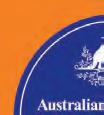


you can simply put it on the line below and date it. That ensures no more uncertainty about which password is valid or if there is a new password written on another page.
Please note that you should never write down your complete password. Asterisk (***) out the body of the password, just in case anyone with bad intentions was to get hold of this information.
In addition to this, keep your password book secure – as if it was as valuable as a wad of cash, as usually it is more valuable than that. Ensure you write your
passwords clearly, and if you make a mistake, cross it out and rewrite it underneath. Trying to write over passwords may save you time today, but it will cause you pain when you go to type it in again in the future.
Indicate clearly if a letter is capitalised: I personally use an underline to demonstrate a capital. Some use a different coloured pen. Ensure you cross out your zeros so there is no doubt as to if it is an ‘O’ or a ‘Ø’.
You might be thinking, “Edin, don’t be silly. Google saves my passwords for me or I keep them saved in a document on my computer. Why on earth would I need to write down my passwords for someone to steal?”
Well, the reason I say this is because I have seen password managers go wrong time after time after time. Firstly, usually you don’t have people you don’t trust in your home in the first place to take your book. This is a valued consideration. However, on your computer, it is becoming
harder to manage who has access. Many times have I seen clients give remote access to a stranger via a program on their computer as a part of a scam.
Remote access has a time and place, but you should never let someone remote access your computer if you have saved passwords. If you can see your passwords on your computer, so can they. In my opinion, it is fine to save some passwords on your computer – but only passwords that are unique and wouldn’t cause devastation if someone were to access them.
Your login to golf or bridge, for example, wouldn’t be an issue. Your bank password or myGov should never be saved by anyone or anything. It simply puts you at too much risk.
Follow these steps and you should have more security and fewer forgotten passwords.
Edin Read is founder and chief technician at Greyology Tech Support for Seniors. Visit greyology.com.au

























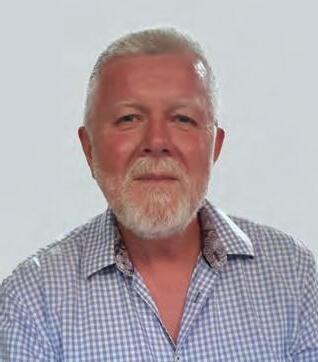





“... It’s simply giving human rights equal consideration and acknowledging that people should retain the same rights as they have now, when they go into aged care.”
Geoff Rowe – CEO of ADA Australia.


Geoff Rowe CEO of ADA Australia, the Queensland organisation in the Older Persons Advocacy Network, talks about the importance of a new Aged Care Act which upholds human rights in aged care as the key to making real change in Australia’s aged care system.
The journey to improving Australia’s aged care system has been ongoing since the release of the sobering Final Report of the Royal Commission into Aged Care in 2021, and we have since seen some important reforms introduced to improve the quality of care. Star ratings, mandatory nursing and care minutes, serious incident reporting changes, and wage increase for care staff, to name a few. Granted, these have not been without their
difficulties to implement, however, will all contribute to bettering the quality of care in the long run.
However, as aged care advocates, older people tell us it is poor communication and lack of choice and control that are the top presenting issues facing older people in aged care, whether receiving services at home or in an aged care facility.
Older people do not feel heard by their service providers and feel that their care concerns are often dismissed or ignored, and that they do not get a say in the things that impact their lives.
To change this, a new approach is needed. The Royal Commission recommended a new rights-based Aged Care Act, one that puts the older person at the centre of the aged care system, and one that is backed by the legislative and regulatory powers that are necessary to enforce it.
The exposure draft of the new Aged Care Act is out for consultation. It shows good intent, and a good start to creating a human rights-based approach to aged care.
However, I am concerned that the draft doesn’t go far enough to really turn the current system’s focus from the ‘business of aged care’ to the ‘people in aged care’.
When you look at what in the draft Act is enforceable, there are new duties under the law for service providers, staff and organisations, which are important, but the new Statement of Rights, which outline the human rights of older people, are not enforceable.
Without any measures to make sure the Statement of Rights are upheld, they simply become good intentions. The rights of older people in aged care
must be given the same importance as measures to ensure the quality and safety of care.
I understand that there is a need to balance safety and rights in service delivery, but how can a balance be achieved if there is no weight on the Rights side of the scales?
My concern is that this imbalance could lead service providers to placing an even greater priority on blanket safety measures over the rights of older people to pursue their quality of life and have agency over their lives.
For example, I can see where it could easily be deemed as ‘safer’ to restrict older residents in aged care from some activities, rather than developing an individual risk managed approach – say a person with early-stage dementia who wants to go out alone to the shopping centre or walk alone in the garden.

Aged care advocates are calling for the Act to be strengthened with service providers to have a positive duty to uphold the Statement of Rights, that rights are directly enforceable and that there are appropriate consequences for breaches.
It’s important to note here that this is not about creating a legal minefield in aged care. It’s simply giving human rights equal consideration and acknowledging that people should retain the same rights as they have now, when they go into aged care.
Those fundamental elements of an ordinary life –being listened to and making choices - what to eat, when to shower, what to do, where to go or who visits.
Embracing human rights doesn’t need to be difficult, it is a change of perspective that needs to be supported by the legislation.
We also recognise that it will take time for service
ADA Australia is your Brisbane aged care advocacy service. Our friendly team of advocates provide free and independent information and support.
• Accessing aged care and getting your aged care services in place
• Information about aged care fees, service agreements, statements and budgets
• Raising and addressing care related concerns with service providers
• Supporting you to have a say in your care and the things that impact you.
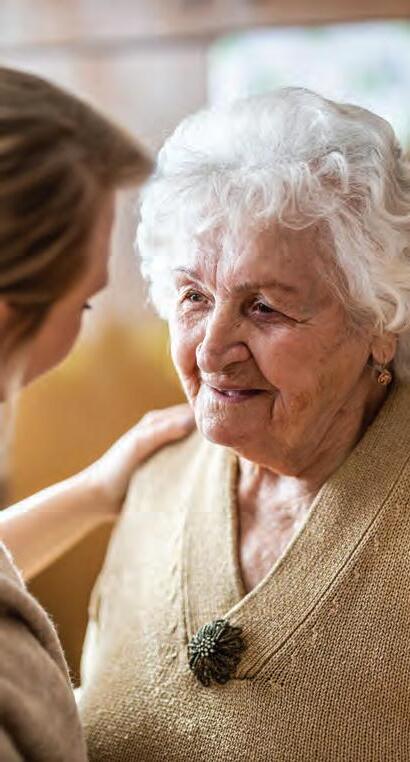

providers to transition to changes that the new Aged Care Act will bring. Advocacy services are here to make sure older people have access to services they are entitled to, are safe and are informed about their rights, while reforms are being rolled out.
The Older Persons Advocacy Network and COTA Australia, in partnership with 10 other older people and carer organisations, have identified 23 key issues that need to be addressed in the Aged Care Act Exposure Draft, available at www.opan.org.au
The exposure draft of the new Aged Care Act is out for consultation until 8 March 2024.
Geoff Rowe is CEO of ADA Australia, the Queensland member of the Older Persons Advocacy Network.
adaaustralia.com.au
We support you to access or get the most from your aged care services, understand service charges and fees and have a say in the things that impact you.
Our service is free, and our focus is on a
Chat with us 1800 700 600
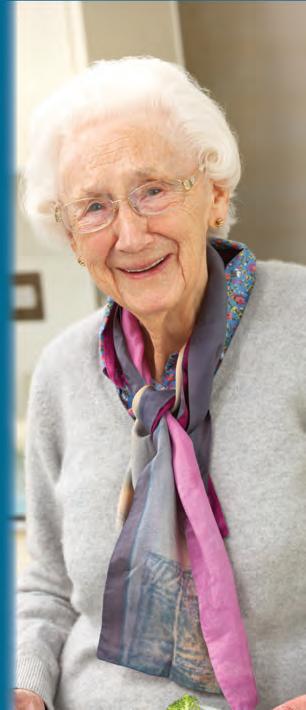

KAILAS ROBERTS outlines the ‘surgery gone wrong’ in the 1950s that provided researchers with a fresh understanding of how new memories are formed.
Scientific progress is fundamentally based on observation. A person must notice something about a situation or process and make an inference.
If it is observed that when A occurs, B also happens, this may lead the observer to surmise they are connected. An obvious case of this is that when someone smokes over a long period, they are more likely to develop cancer.
But the observation does not mean that one causes the other – just that there is an association. To prove so-called causality, you have to design an experiment that removes other influencing factors.
For example, smokers may also eat more poorly, and perhaps that increases the risk of cancer – meaning that you must ensure the participants in the study all eat the same food.
Sometimes, you can’t conduct an experiment like this, however, and have to rely on other things such as the magnitude of the connection between A and B, whether it is biologically plausible and whether one thing always precedes the other.
Interestingly, there has never been an experiment proving smoking causes lung cancer. This would involve asking one

group of people to smoke, and another not to, and then measuring the rates of cancer in the two groups.
Given that observational data so strongly supports a link, it would be unethical to make any of the study participants smoke at all.
Despite this limitation, there is universal consensus that smoking does, indeed, cause lung cancer.
When it comes to understanding how we remember things, a critical piece of observation came from a surgical error in 1953. The victim, for many years known only as ‘HM’, suffered severe epilepsy, and underwent an operation to prevent him having seizures.
The operation was a success in this way (his seizures stopped), but a disaster in another. As he recovered from his operation, his doctors noticed he could not remember things.
Well, that’s not quite true. He could remember the bulk of things that had happened in the time before the operation, but his ability to remember anything new was obliterated. Famously, he described his experience as “like waking from a dream … every day is alone in itself”. He could not learn new words, facts or faces, and he would even forget who he was talking to the moment he walked away.
This catastrophe occurred because his surgeon had removed 8cm of tissue from his hippocampus: a small seahorseshaped structure in his temporal lobe.
Up until that point, the importance of this structure was not known, but this ‘surgery gone wrong’ created a fresh understanding of how new memories are formed.
Observations about HM led to huge amounts of research focusing on this part of the brain (and on HM himself), and the hippocampus has come to be widely recognised as critical in forming new memories.
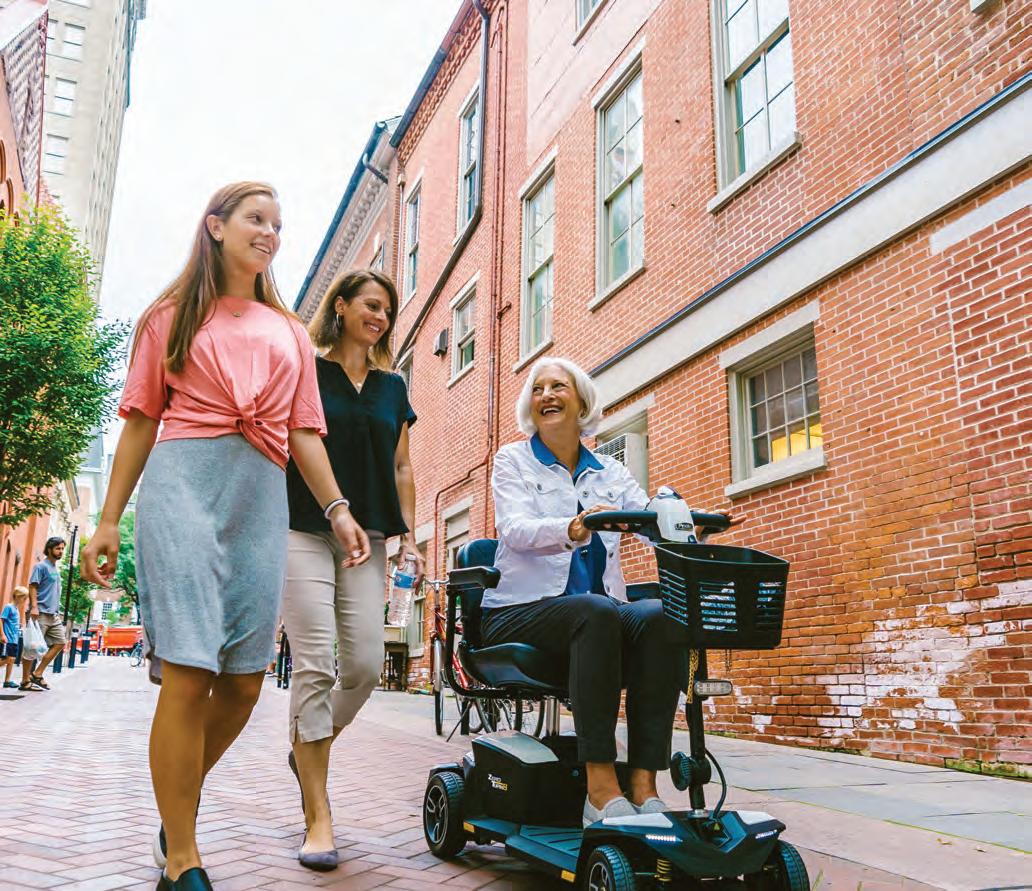
HM was still able to complete tasks, and even get better at them over time, making it clear that the hippocampus is less important for these so-called procedural memories.
These include riding a bike, driving a car and other ‘auto-pilot things’ that we do.
We now know that the hippocampus is one of the first areas of the brain to be affected in Alzheimer’s disease, leading to the typical forgetfulness of recent events, and that other areas of thinking can be relatively well preserved early on.
HM went on to live for many decades, dying in 2008. Although there is, of course, a tragedy to his story, at least his legacy has been one that has enriched medical research and will hopefully in the end hasten our progress in finding a cure for this difficult disease.




Kailas Roberts is a psychogeriatrician and author of Mind Your Brain: The Essential Australian Guide to Dementia available at all good bookstores and online. Visit yourbraininmind.com or uqp.com.au











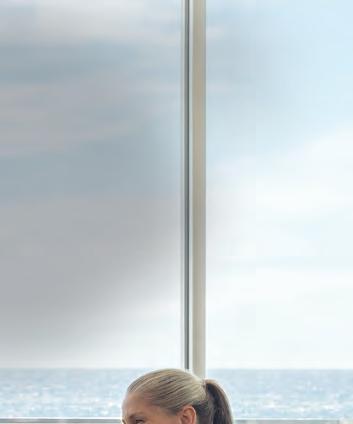
SHIRLEY SINCLAIR speaks with a compassionate woman who fulfilled a long-held business dream late in life.
As a young adult, Di Niass always lamented never visiting her father Brian’s gravesite.
It took her 20 years and the passing of her mother Patricia before she made that pilgrimage.
But now, at 65, she not only empathises with people feeling similar pangs of regret but also has followed through on a long-held dream to create a service to give them peace of mind that, in their absence, loved ones’ graves are being cared for.
Grave Thoughts is a specialised floral-delivery and gravesitemaintenance service that can ensure the year-round upkeep of a loved one’s resting place.
With the utmost dignity and respect, the service, established in 2022, promises: “To show them you care, we can be there. When you wish you were near, we will be here”.
“My father passed away when I was 16. My mother had been left to bring up five children – we are talking about in the early-’70s,” Di recalls.
“Well, my mum had her hands full just trying to survive and also trying to do the best for us kids.
“She didn’t have time to go and grieve

or sit by a gravesite and talk to dad and she probably didn’t want to.
“She was probably thinking, ‘It’s okay for you. You’ve gone, put your feet up and left me with these five little rascals. I haven’t got time to talk of such matters. I have to get on with the hand that life has dealt me’.
“We were young kids trying to make our way in life without a dad. So, the

years passed and we all went on.
“Then, my mum passed away. We were all an adult age by then: working, married, not depending on our mum and it was then 20 years later.
“I realised I had never visited my dad’s grave and now I was going to because of the passing of my mum.
“Well, the gravesite wasn’t dilapidated because my father’s brothers and sisters had visited on occasions over the years and that made me feel good.”
Di understands only too well that there can be a variety of reasons why it may be challenging for people to personally tend to their loved one’s resting place – from geographical constraints and demanding work and life schedules, to physical or emotional limitations, or the distressing nature of the task.
A resultant feeling of neglect can further exacerbate the emotional burden.
“I was living interstate and working. So, when it came to my dad’s birthday or even my mum’s, I wasn’t able to go visit their resting place and this troubled me, even though they had passed,” Di says.
“I needed to say, ‘I’m thinking of you on this special day and thank you, because if it wasn’t for you, I wouldn’t be
the person I am today’.
“So, my dream began and now 30 years later, I’m following that dream.
“I suppose the moral of the story is never give up on your dream. I’m not.”
Grave Thoughts’ specialised services can be customised to specific needs and honour the memory of loved ones on special occasions such as birthdays, anniversaries, Mother’s Day, Father’s Day, religious holidays, or any other significant event.
As Di says: “Just because they are gone doesn’t mean they should be forgotten.”
The cost of individual and special occasion services varies, tailored to meet the specific needs of customers. They include:
• flower replacement
• candle placement and lighting
• reading a memory or special verse
• playing a favourite song
• headstone cleaning
• weeding, trimming, cutting and tidying turf
• cleaning or replacement of pebbles or vases
• maintenance and cleaning of existing decorative flora.
Visit gravethoughts.com.au
Sometimes,theconsequencesofgastricrefluxaremoreseriousthanheartburnor regurgitation,andcouldbecausing,orcontributingtomoresignificanthealthconditions.

Gastricrefluxcontaminationmayoccurthroughouttheheadandneckandcanbethecauseofearandsinusinfections, sorethroat,andadifficultyinswallowing.Refluxcanalsoirritatetheairwaysandbeaspiratedintothelungscausing chroniccough,constantthroatclearing,breathingdifficulties,recurringchestinfections,bronchitis,orpneumonia.
Availableattwoconvenientlocations,ourpatented&exclusiveGastroesophagealRefluxTestaccurately detectsthepresenceanddeterminestheextentandseverityofgastroesophagealrefluxdisease.
Thefirstofitskind,thisnon-invasivenuclearmedicineimagingtechniqueaccuratelyidentifiesgastric fluidcontaminationthroughoutthemaxillarysinuses,throat,middleears,laryngopharynx,airwaysand lungs.
Ifyouthinkyou'dbenefitfromaGastroesophagealRefluxTest,talktoyourdoctoraboutareferralto CitiScanRadiologyorLimeRadiology.Visitourwebsiteslistedbelowformoreinformation


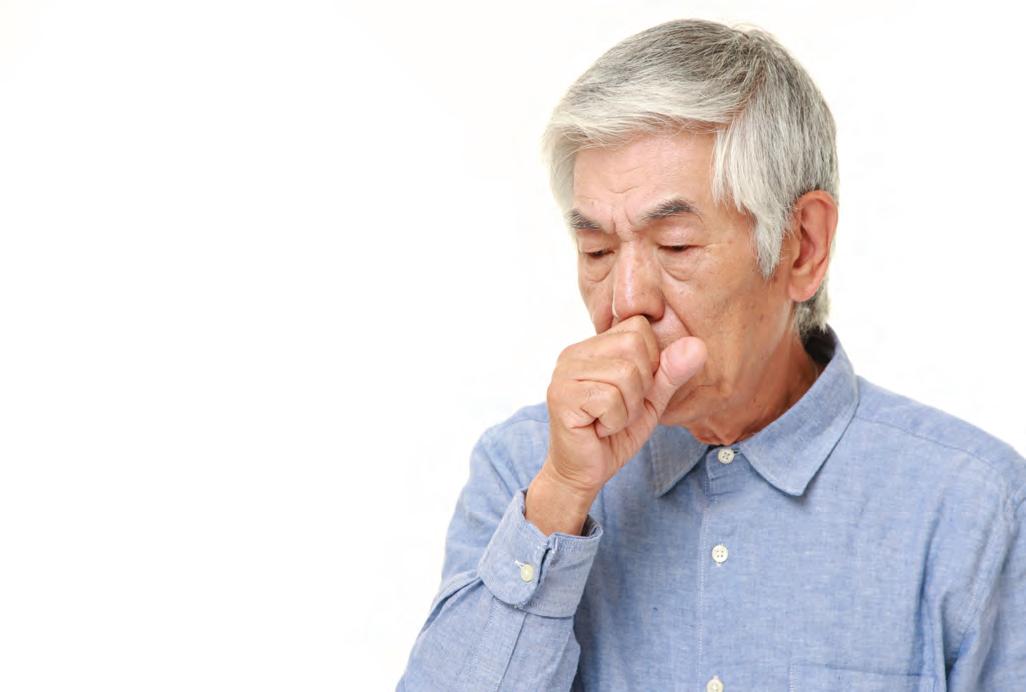

0732839200


EVERY day, people make excuses as to why they don’t need a Will to ensure their valuable assets pass to their family.
Classic excuses include:
• I don’t need a Will because my wife/kids are going to inherit everything anyway. She/they’ll take care of it.
• Isn’t that for rich, old people?
• I only have a house, not much to worry
PREPARING a Will for the first time can be confronting, as I found as a 34-year-old.
A year-long trip around Australia with our then five-year-old and two-year-old sons forced us to sit down with a lawyer friend and have a chat about our assets: how we would like them to be distributed in the event of a variety of ‘what if?’ scenarios while on the road.
Our biggest fear was to die intestate: not having left a valid Will. In Queensland, if a deceased estate is identified as intestate, the assets of the estate are distributed according to the Succession Act 1981. That means that a court will decide who inherits what, according to an order of succession. That will begin with the closest relatives of the deceased –usually the spouse and children, if living.
But that could fail to take into account the wishes of the deceased. Families being families, that ‘order of succession’ may not ultimately reflect what the deceased really wanted to do but never got around to



about, really.
• Getting a Will is too expensive and time consuming.
• I’ll be dead anyway, so it’s not my problem.
• If I talk about it too much, I’ll probably jinx myself.
The response to all of these furphies is a resounding “wrong!”.
While not having a Will may mean that ultimately assets eventually find their way to next of kin, the pathway is longer, more expensive and requires court involvement – overall, a much slower and much more-expensive way to achieve the outcome that a straightforward Will could ensure.
Of course, not having a Will means that your intentions are irrelevant and what you wanted to happen may not occur.
putting down on paper. It also could leave out provision for someone they had considered a significant person in their life, such as a neighbour, not take into account specific desires (for example, leaving a vintage car to a grandchild who is a motoring enthusiast), or reward people whom the deceased considered unworthy.
My parents subscribed to KISS (keep it simple, stupid!), and so made a simple Will with the help of the Public Trustee. Dad left everything to my mother when he died. When mum passed 10 years later, all assets were divided up equally between their four adult children. But our 1996 Will had to be slightly more complicated. Who would become guardian of our boys in the event their parents die in an accident on the road? How would our assets be divided if all four of us were fatally injured?
It took us until 2018 to revise our Wills but we should have started that process many years earlier – say, when the boys turned 18. Of course, blended families add to the complexities. So, a Will is not a ‘one size fits all’. The main ‘takeaway’ here is that whenever your circumstances or those of your beneficiaries change, review and revise or possibly make a new Will.
When people die without a Will (called an intestacy), the law sets out a formula that applies to distribute assets in different proportions between next of kin in a specified sequence. That may, for example, mean a house has to be sold, even if the wife is living there, to satisfy the intestacy formula.
The absence of a Will may open the door to a contested estate.
A simple Will would prevent unintended consequences occurring.
A simple Will is not expensive (usually
under $500). Unless the estate is complex, there is no need for a testamentary trust or other complications to blow out the costs of a Will. In fact, lawyers make much more money when people don’t have a Will, as the sorting out of people’s estates without a Will significantly increases the time and expense involved.
Brisbane Elder Law are experts in wills, estate disputes, estate management and retirement village contracts. Call 1800 961 622 or visit brisbaneelderlaw.com.au





















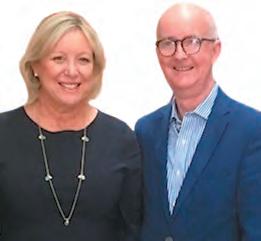
Australia’s subsidised aged care services now help around 1.5 million older people to receive care and support. Taxpayers contributed A$28 billion to the various programs in 2022-23. And yet the system is governed by an act that was first passed in 1997.
A lot has changed over the past two and a half decades – more people are living longer with chronic conditions and impairments that necessitate care, more of that care helps people stay in their own home, older people have more choice and control, and quality and safety are subject to tighter regulation and improved enforcement. These and many other reforms are welcome. But as a result, the 1997 Aged Care Act has become a patchwork of change upon change. So when is the new act due, and what does it aim to achieve.
What we know so far: Following the report of the Royal Commission into Aged Care Quality and Safety, the government is rewriting the act with a view to it commencing on July 1 2024 – less than five months from now. Parts of an initial draft of the act have been released for public consultation. The proposed act adopts a rights-based approach to caring for older Australians, and consolidates and simplifies multiple pieces of existing legislation.
Some of the improvements will include: establishing a complaints commissioner to
increase the independence and transparency of investigating aged care complaints; increasing whistleblower protections so older people, their families and aged care workers feel comfortable about exposing unacceptable treatment from a provider; streamlining access to aged care through a single-assessment process, rather than older people having to be assessed by different organisations depending on their particular care needs.
But several significant issues have yet to be addressed. The partial draft of the act lacks any provision relating to the proposed fees, payments and subsidies, or about how people with different needs will be prioritised and how aged care places will be allocated to them.
The act also makes many references to the government making rules about how the aged care system will actually operate. As always, the devil is in the detail but the rules have not yet been made public.
The new act also attempts to address the fundamental concern that Australia’s Constitution doesn’t provide the federal government with powers to make laws specifically for “aged care”. This is unlike the government’s powers over banking, marriage, the age pension and many other matters. Instead, the act attempts to patch together a range of other powers, such as for providing sickness and hospital benefits
and making binding international treaties (including disability support) under its external affairs powers. It is unclear whether this approach will make the system too complex, compared with seeking agreement from the states to refer their powers to the federal government, or to enact a common set of laws on which both levels of government agree.
Federal Parliament will have the final say on what the act will contain and when it is passed.
How does this fit with other recent changes? The new act aims to provide an enduring structure that brings the current aged care system, including recent reforms, into a single consistent regulatory regime.
The newly introduced residential care workforce standards, for instance, will be carried over to the new act. They include the requirement for 24/7 cover by registered nurses, so nurses are always available to care for a resident when needed, at any time of the day or night. The new levels of care minutes that nurses and other personal care workers must provide to residents will also be part of the new act.
The act will also include the Star Ratings for individual aged care homes. These help inform residents about the quality of the care their homes provide.
Will this be it for a while? The recent changes to aged care are not the end of the
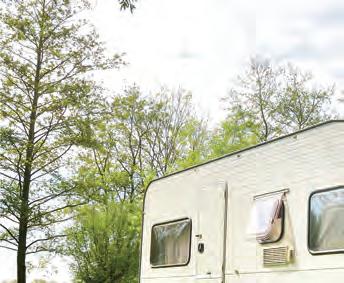
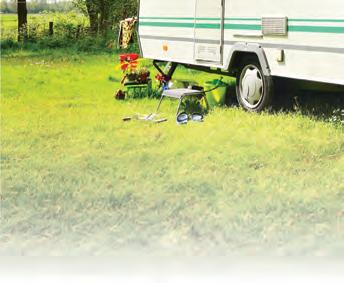
decade-long reform journey. In the immediate future there will be changes to payment arrangements for care as the government responds to the yet-to-bereleased report of the Aged Care Task Force.
Following that, a new Support at Home program is being designed to consolidate and streamline the current home care packages, short-term restorative care and respite care. Having already been deferred twice in recent years, the current proposed start date is July 1, 2025.
The drafting of a modern, simplified act is an important opportunity to provide the best legislative regime for caring for older Australians. But such an opportunity comes only once every decade or two. While the new legislation needs to put older people at its centre, it must also facilitate a system that is sustainable and sufficiently robust to support them to access subsidised care when they need it.
The broad framework is there, but there are less than five months to get the details right.
* This article first appeared in The Conversation. For the full article, go to: theconversation.com/changes-are-comingfor-australias-aged-care-system-hereswhat-we-know-so-far-222757
By Michael Woods, Professor of Health Economics, University of Technology Sydney, and Eugenia Tsihlis, Senior Research Assistant Law Health Justice, University of Technology Sydney

DEMENTIA Australia has released new data that shows the number of people with dementia is expected to nearly double by 2054.
Research commissioned by Dementia Australia and undertaken by the Australian Institute of Health and Welfare reveals that dementia rates will increase by 93 per cent by 2054.
In 2024, there are more than 421,000 people living with all forms of dementia in Australia. By 2054, without a medical breakthrough, this will grow to 812,500 people.
Dementia Australia CEO Maree McCabe says there will be increasing demand for support services for people living with dementia, their families and carers.
“Dementia is the secondleading cause of death of all Australians and the leading cause of death for women,” Ms McCabe says. “Provisional data is showing that dementia will likely soon be the leading cause of death of all Australians.
“It is one of the mostsignificant health and social challenges facing Australia and

the world. This data will help to inform planning and funding of services and programs around Australia to meet current and future needs.”
All Australian states and territories will experience an increase in the number of people diagnosed with dementia over the next 30 years.
Western Australia will witness the highest growth of people living with dementia at 109 per cent.
Queensland is expected to increase at 100 per cent.
Visit dementia.org.au/ information/statistics/ prevalence-data or call the National Dementia Helpline on 1800 100 500.
DRY eye disease is a common issue affecting millions of people around the world.
Most dry eye is not caused by a lack of tears, but poor-quality ones. Tears are a delicately balanced mixture which includes oils and immunologic particles. They form a film which nourishes the surface of your eyes and keeps your vision sharp.
If your eyes stay dry for a long time, they can feel tired and uncomfortable. While traditional remedies such as lubricating eye drops are important and can offer
temporary relief, newer treatments such as Intense Pulsed Light (IPL) therapy offer hope for managing this condition more effectively in the long term.
IPL therapy targets the inflammation affecting the eyelids and meibomian glands. It helps these glands work better and can improve the quality of the tears by encouraging the glands to produce more oils, with the effects lasting a long time.
Insight Eye Surgery, Taringa. Call 3154 1515 or visit insighteyesurgery.com.au
HEARING loss affects people of all ages.
The skilled experts at Audika Australia can carry out in-depth consultations to assess unique impact of hearing loss in your life. So, you can love your ears and keep being you.
Matt Knight is one of the many talented clinicians at Audika Australia. Matt, who is based in the Brisbane clinic, exemplifies Audika’s mission to help more people hear better through excellence in care.
LIFE can often feel like a tiresome journey, but the key to staying alert lies in the quality (not quantity) of our sleep.
Prioritising sleep quality:
1. Promotes heart health: by providing vital relaxation and rejuvenation for the heart, reducing the risk of heart issues.
2. Maintains hormonal balance: consistent sleep schedules keep hormones in check, supporting alertness and wellbeing.
3. Manages weight: by playing a crucial role in regulating metabolism.

Matt discovered audiology through his passion to help people achieve an improved quality of life. Untreated hearing loss can have a range of negative consequences on an individual’s life and can lead to safety concerns, putting them at higher risk of falls, for example.
Book your free hearing check at audika.com.au/seniors-card or call 1800 028 843.
4. Strengthens the immune system: by actively restoring and fortifying the immune system, reducing susceptibility to infections and illnesses.
5. Enhances energy and recovery: by ensuring proper cell regeneration and sustained energy levels.
6. Improves mental sharpness: by enhancing focus and memory.
For those facing issues such as insomnia or sleep apnea, resources, including CPAP therapy, can significantly improve sleep quality.
Visit cpap.com.au/locations
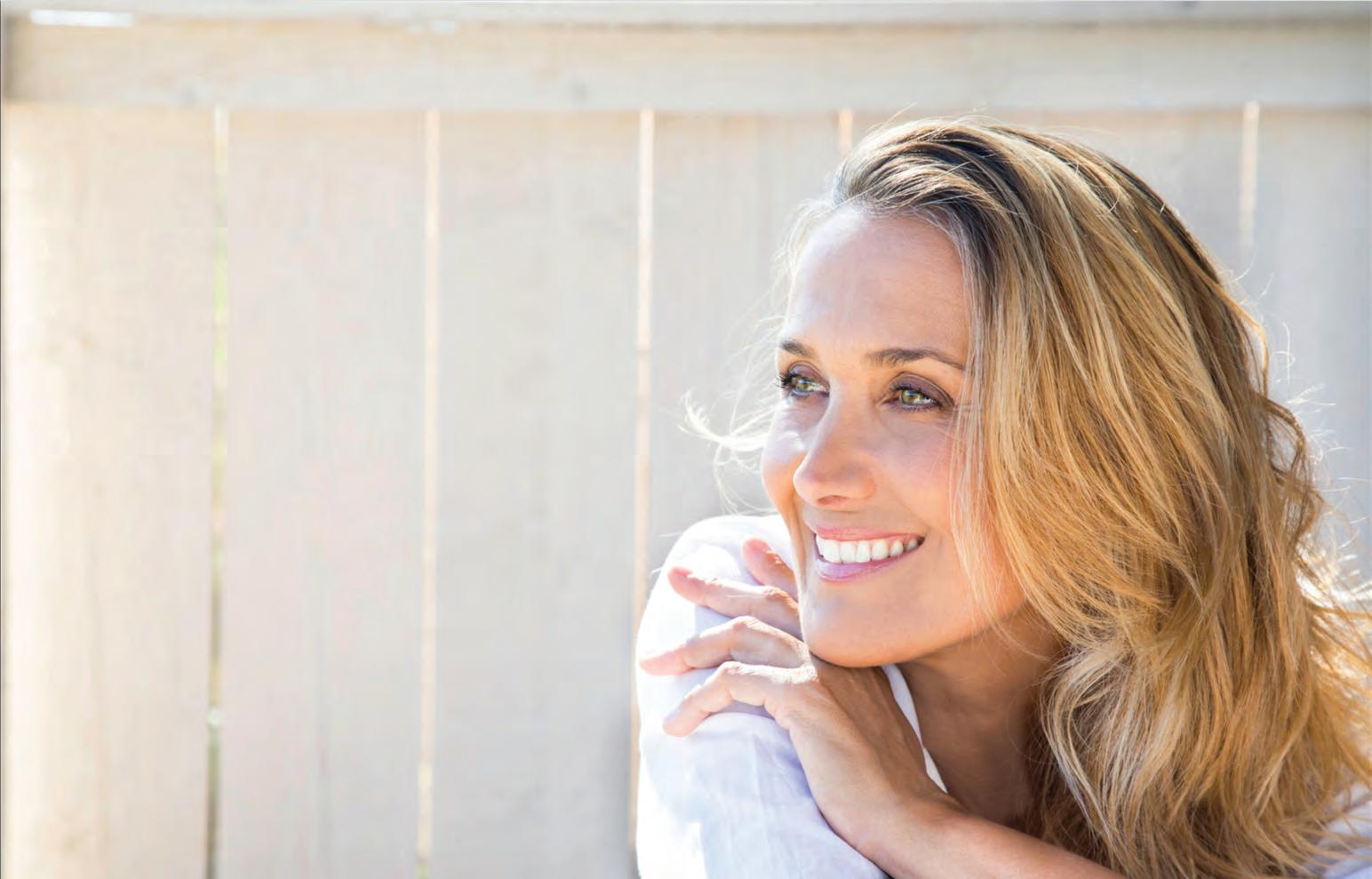

RETIREES seeking to join Aveo’s popular Sunset Palms retirement community in Palmview must get in quickly, with limited villas remaining in the latest collection of architecturally designed homes.
The second stage featuring 22 spacious villas, released last year, was eagerly anticipated, attracting downsizers to the vibrant community ideally situated for the Sunshine Coast’s pristine beaches and serene landscapes.
Sales manager Aimee King says the community’s residents are thriving in the village’s relaxed lifestyle after leaving
behind their high-maintenance homes.
“With its resort-style facilities and boutique village charm, Sunset Palms, which launched in 2019 with the first 38 villas, has been sought-after by retirees ready to launch their next chapter,’’ Ms King says. “The community is only 15 minutes from the sandy beaches of Mooloolaba and 20 minutes from the lush hinterlands and bustling shopping paradise of Sunshine Plaza.’’
Positioned in a private corner of the masterplanned Harmony residential estate, Sunset Palms benefits from 130ha of green space and extensive walking trails.
Upon completion of Harmony’s planned town centre, Sunset Palms residents will enjoy convenient access to retail amenities, including a supermarket, cafes and restaurants.
“Many of our residents had already been living on the Sunshine Coast and wanted to stay in an area they love, while others were drawn to the community to stay connected with family who reside in the Harmony Estate,’’ Ms King says.
While villas are limited, various designs are still available, including twoand three-bedroom floorplans – some with two-car garages and extra living areas.
“The stylish villas are open-plan design, with full-sized kitchens, premium inclusions, lock-up garages, outdoor entertainment areas and grassed backyards that residents don’t need to mow,’’ Ms King says.
“Everyone’s so happy with their beautiful homes. The response I most often hear is ‘wow, it’s stunning and more than we imagined’. Villas are also cleverly designed with discreet features to allow safe ageing in place without stairs or trip hazards, so residents can look forward to carefree living.’’
Sunset Palms’ residents share an outdoor pool, gym, salon, bar, billiards table, function room, library, media room, art space, bocce court and communal vegetable gardens. A community bus is available for shopping trips to Maroochydore and Kawana.
The busy social calendar offers something for everyone, including regular events, happy hour, book club meetings, mahjong sessions and art classes.
Sunset Palms is at 58 Harmony Boulevard, Palmview, with villas priced from $545,000.
For more information or to tour the site, call 13 28 36 or visit aveo.com.au

RV LIFESTYLE Village Oceanside at Burnett Heads, on the coast of Bundaberg, is designed with the active retiree in mind. Every home features an RV-sized garage (on average 16m x 6m with garage door clearance up to 3.6m) – big enough for the RV, boat and a couple of cars.
The homes are meticulously designed to optimise space without sacrificing style or comfort. From the high-roofed,
oversized garages to open-plan living spaces that blur the lines between indoor and outdoor living, the homes at RV Oceanside are designed to make the most of our beautiful Queensland climate.
When you’re at home, there’s plenty to do. A suite of best-in-class facilities include a lagoon pool, games room with self-serve bar, two tenpin bowling lanes, pool tables, table tennis, a golf simulator and lounge.
There’s also a gym, library, art and craft room, meeting room, barbecues, firepit and a residents’ workshop.
The next stage of facilities, set to start construction this year, will include a cinema, clubhouse, covered lawn bowls, tennis courts, community vegetable garden and catering kitchen, as well as a casual lounge and dining.

Now home to more than 200 residents and growing fast, this is not just a place to
live but a community to be part of. There’s something for everyone – from complimentary group fitness classes, to arts and crafts, woodworking, community barbecues ... the list keeps growing.
When friends and family visit in their van, they can enjoy a complimentary stay on the powered and serviced hardstand. When you’re heading off, you can lock up and leave, knowing all the community facilities and gardens are maintained and your home is secure in a gated community.
Stage 2 homes are under construction. Prices start at $695,000, and move-in-ready homes are available. Book for a noobligation tour, try the facilities, and enjoy a free two-night stay on the hardstand.
RV Lifestyle Village Oceanside is at 50 Marshall Street, Burnett Heads. Find the page on Facebook, visit rvlifestylevillage. com.au or call 4155 5035.

WITH a warm and inviting community already calling Rendu Towers home, now is the time to discover Ozcare’s newest retirement village benchmark in the diverse precinct of Newstead.
With only two exclusive towers built within this stunning retirement village, Rendu Towers was specifically created for independent living for retirees over 65 who want a sense of community, convenience, security and luxury.
Creating an inclusive and welcoming community is one of Ozcare’s core values for all eight of its retirement villages across Queensland. One of the state’s mosttrusted aged-care providers for nearly 30 years, Ozcare is focused on delivering an unparalleled retirement living experience.
Ozcare co-locates its retirement villages with residential aged care and supports village residents with home-care services.
Setting a new benchmark for retirement living, Rendu Towers provides peace of mind knowing care is easily accessible if needed in the future, and delivers design brilliance with timeless architecture and some of the area’s best river, leafy urban and mountain views.
It’s an address like no other. Soaring above the Brisbane River and located in one of the capital city’s most liveable precincts, retirees can enjoy the Riverwalk, ferry rides, bike pathways, and numerous relaxing green spaces, including accessible dog parks.
The North Tower is sold out. With the final release of the South Tower now selling, book a village tour and see why so many retirees call Rendu Towers home.
Residences start from $720,000.
To learn more about the two- and three-bedroom apartments, visit rendutowers.org.au or call 1800 692 273.
BRUCE McMAHON has found a compact electric vehicle that ticks the boxes as an economical, everyday ride for suburbia.
This three-door Italian is the right size and the right fit for an electric run-around.
It’s cute and compact and may rarely venture far from metropolitan limits and re-charging sources.
Fine to run from Brisbane to Broadbeach, but unlikely to be asked to take a spin out to Birdsville.
It’s not cheap at $52,500 but it is more fit for purpose than any number of other electrics.
The buzz about electric vehicles has been a little over-hyped – especially when it comes to larger (and heavier) family sedans and SUVs.
Take Hertz’s experience for example.
The American rental car company is now throwing some 20,000 electric vehicles – many of them Teslas – off its fleet and replacing them with petrolpowered cars. Why? High repair costs and rapid price depreciation.
Yet there remains a case, at this stage of battery-electric vehicle development, for the likes of Fiat’s 500e: small cars well-suited to city life, rather than high-mileage renters driven by Tom, Dick and Harry.
The Fiat’s 300km or so battery range,

and the cost when there are cheaper Chinese alternatives, may not impress eco-rationalists. But this is a mostentertaining compact, ideal for economical urban motoring with flair.
The Italian-built 500e is a touch bigger (56mm wider, 61mm longer) than regular, petrol-engined 500 hatchbacks, but still comes in at a friendly 3.6 metres long by 1.6 metres wide.
Some more numbers: the frontmounted electric motor puts out 87kW with peak torque of 220Nm – good enough for 0 to 100kmh in nine seconds.
Fast DC charging at 85kW should get the 500e from 0 to 80 per cent in 35 minutes and, with a claimed range of 310 kilometres, one charge should be enough for a week of average commutes. The 500e’s price tag – compared with around $28,000 for a petrol Fiat 500 –brings not only electric propulsion but also other cosmetics and comforts: from smart 17-inch wheels to a fixed glass roof, heated front seats to eco-leather seat and door panel trim. That’s on top of safety gear such as tyre pressure monitoring and lane centring.

This adds up to a premium cabin, a fair size for two average adults up front and two, for a short ride, in the back seats; entry to the rear can be a scramble. With those rear seats up, there’s not a huge amount of cargo space – maybe enough for a long weekend.
Back up front, drivers sit comfortably with good visibility to front and sides, although anyone close on two metres could find forward vision cut by the windscreen rail.
Controls and instruments, with centre touch-pad and a row of push buttons for gear selection, are relatively straightforward and there’s the big dial to show how much juice is being used (or saved).
There are three drive modes: Range which makes the most of regenerative braking; Normal for day-to-day; and Sherpa for saving power when the battery’s low.
This is an easy, comfortable car to drive. It’s also fun to drive with confident steering, decent ride and enough pep to stay out of traffic troubles.
The Fiat 500e has a distinct character not always found in today’s battery electric vehicles.


REDLAND Museum will host the Heritage & Harmony Fiesta on Sunday, March 24 – a free community event for the whole family.
From 9am to 3pm, visitors can immerse themselves in the richness and diversity of multicultural life in the Redlands.
The event promises to be a day filled with entertainment and education, and visitors will be treated to an incredible lineup of multicultural dancers and entertainers.
From the elegant Regency Dancers to the vibrant Rio Carnival Samba

NorthPineBushPoets northpinebushpoets.com.au


Brazilian dancers, there will be no shortage of excitement and energy.
One of the highlights of the day is the hula workshop. Participants can learn the beautiful art of hula dance and even receive a free Hawaiian Stamp Tattoo to embrace the tropical vibes.
In addition, the enchanting sound of the Scottish bagpipes will create an atmosphere of mystery and awe.
Children will also have a blast at the fiesta. Fairy Raine will be offering masterpiece face painting, and Johnny the Jester will perform a captivating magic show. Kids can also enjoy a ride
PERFORMING
Sunday March 3rd and Sunday March 17th
Come and join us!
9am till noon
We meet on the first and third Sunday of each month
Old Petrie Town – Heritage Village Markets
Dayboro Road, Petrie Call Manfred - President 0411 160 510
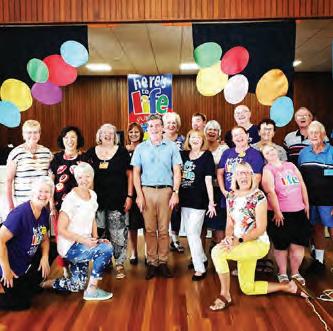
Learn fun dance routines from Fosse jazz, to modified hip hop, to musical theatre – whatever your taste, we’re sure to cover it.
Get your toes tapping in no time. Great for circulation and leg strength.
Find your rhythm on the African Djembe drum. Easy to learn and super-fun.
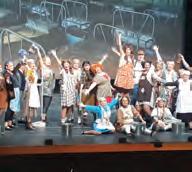
on the land train, visit the petting zoo and take part in the interactive Thomas the Tank train set and craft table.
For those interested in traditional crafts, there will be Indigenous workshops on bead making, weaving and boomerang painting.
The Redlands Spinners and Weavers group will also be demonstrating ragmatting, spinning and weaving.
There will be plenty of food vans offering a wide range of multicultural cuisines from around the world.
The Heritage & Harmony Fiesta is a unique opportunity to discover and explore different cultures calling the Redlands ‘home’.
With the support of the state government and Redland City Council, this event showcases the diversity and richness of the community.

ALL artists like to break the rules and manipulate their chosen media to push the boundaries.
So, the work on display at the Matthew Flinders Art Gallery will be new and exciting. Many different surfaces have been used, including paper, fabric, canvas, clay, timber and plastic. The work in this exhibition scratches the
surface in a literal and metaphorical sense. The creative, innovative artists invite everyone to view the results of their scratchings.
WHEN: March 11 to 24.
WHERE: Matthew Flinders Art Gallery, Bribie Island Community Arts Centre, 191 Sunderland Drive, Banksia Beach.
TICKETS: Free entry.
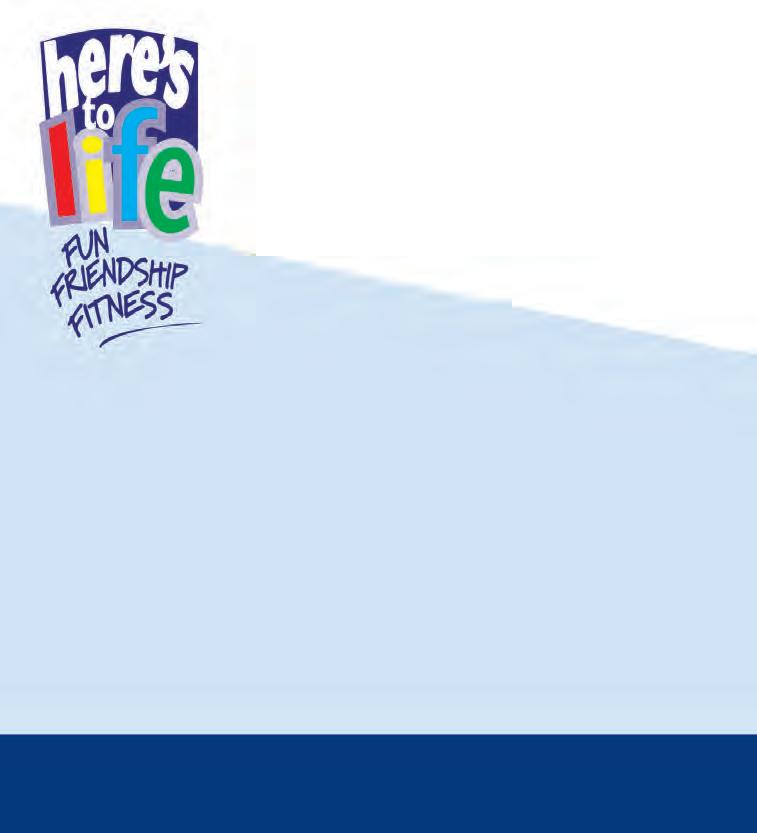
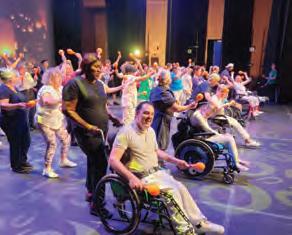
Optimise bone density, balance & strength with this medically endorsed program. Safe for people with osteoporosis.
Give rein to your voice and feel the joy of singing with this inclusive group.
Art Therapy/Art/Craft • Drumming/Percussion • Dancercise
No one is considered unable to take part, and all participants are actively assisted and encouraged to grow their abilities. And the exciting part is that they do.
Classes are conducted in Cleveland with new classes opening on a Thursday. For a timetable or further information please email admin@herestolife.org.au or phone Renee on 0408 717 342 to book your free lesson. www.herestolife.org.au



IAN Stenlake and Michelle
Fitzmaurice will take guests on a captivating musical journey through Academy Award-winning songs that have graced the silver screen.
Following the resounding success of the national tour of Lloyd Webber and The Great Composers, musical theatre and television sensation Stenlake joins forces once again with the awardwinning singer/actress Fitzmaurice to bring song classics from 1935 to 2020 to the stage.
From the timeless Lullaby of Broadway and Over The Rainbow to enchanting melodies such as It Might as Well Be Spring and Can You Feel the Love Tonight from The Lion King, this show is a treasure trove of hits that will keep you mesmerised from start to finish.
Behind each song is a story waiting to be told, which this duo will weave throughout this stunning

production, taking you on an unforgettable musical journey through eight decades of much-loved songs. This performance is brought to you by Promac Productions: the stellar team behind the sell-out Spirit of the Anzac and The Broadway I Love performances at RPAC. Tickets for the show and are selling fast.
WHEN: Wednesday, March 20, at 11am.
WHERE: Redland Performing Arts Centre, 2-16 Middle Street, Cleveland.
TICKETS: Seniors/ pensioners start from just $28. Visit rpac.com.au or call the Box Office on 3829 8131 (booking fees are $6.40 online and $5.30 by phone per transaction).

HERE are some dates to keep in mind this month.
• March 1-31: Australian Adopt a Pet Month
• March 1-31: Epilepsy Awareness Month
• March 1-31: World’s Greatest Shave for the Leukaemia Foundation
• March 3: World Wildlife Day; Clean Up Australia Day
• March 1-7 Hearing Awareness Week
• March 8 International Women’s Day
• March 10-16 World Glaucoma Week
• March 13-20: Coeliac Awareness Week
• March 17: St Patrick’s Day
• March 20: World Oral Health Day; International Day of Happiness
• March 21: World Down Syndrome Day
• March 18-24: National Harmony Week
• March 29-April 1: Easter.
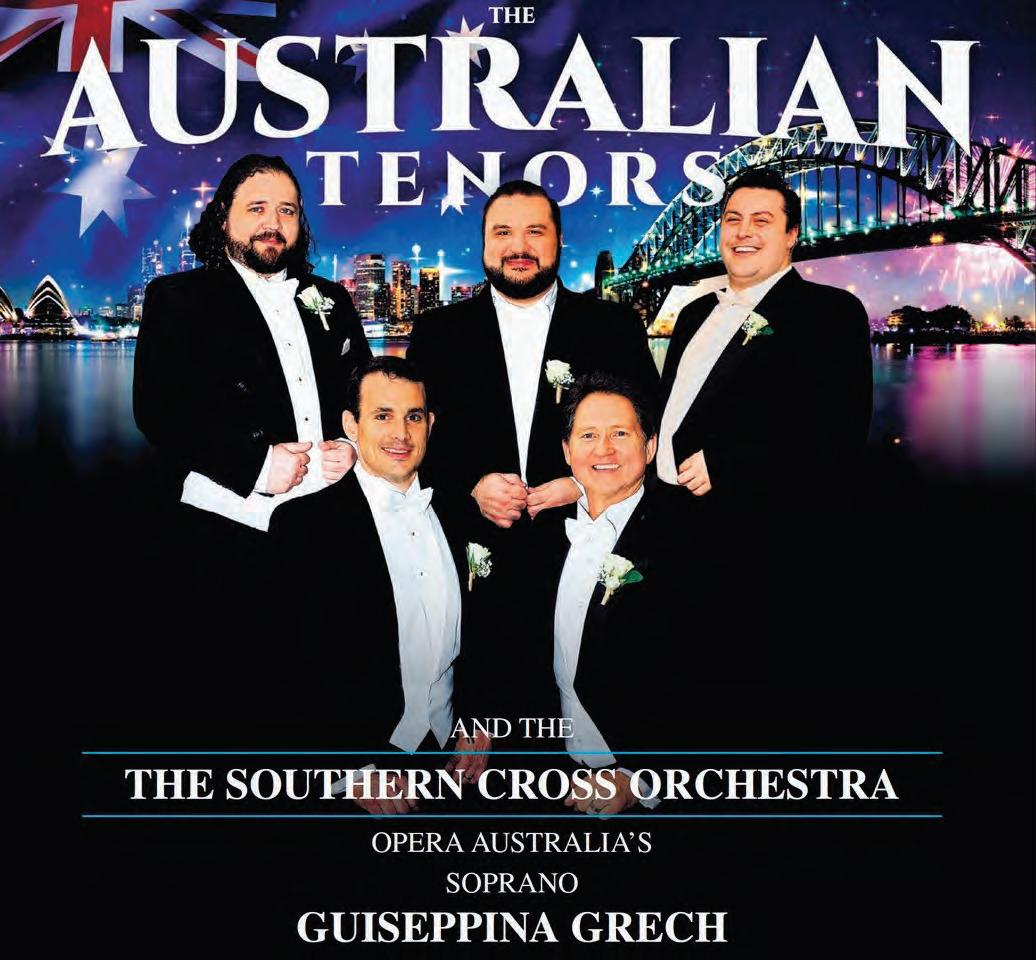

In honour of Easter, here’s a scrumptious recipe to make with the grandchildren or neighbours’ kids. Or why not just indulge yourself (go on, we won’t tell anyone!).
Makes 6.
Ingredients:
• 6 traditional hot-cross buns, halved
• ½ cup Nutella
• 24 marshmallows.
Method:
1. Preheat oven to 180°C. Spread the cut side of each hot-cross bun with Nutella.
2. Place bun bases onto a baking tray lined with baking paper.
3. Top each bun base with four marshmallows. Cover with bun tops.
4. Gently press to sandwich together.
5. Bake for six minutes or until the marshmallows melt.
6. Serve immediately. This recipe was provided by Kim McCosker, of 4 Ingredients.

Redland




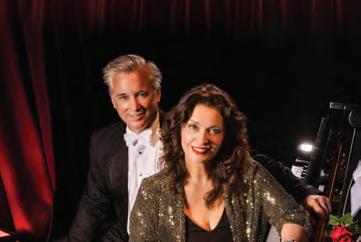

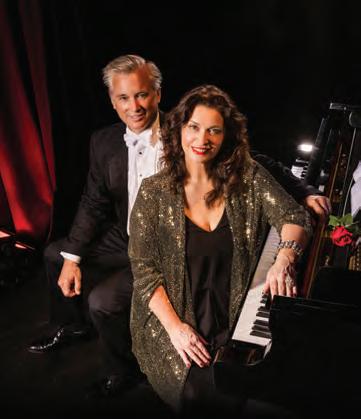
A century of Academy Awardwinning songs brought from the silver screen to the stage!
Wednesday
Redland
Tickets: $28 – $37
Book now! 3829 8131 or rpac.com.au
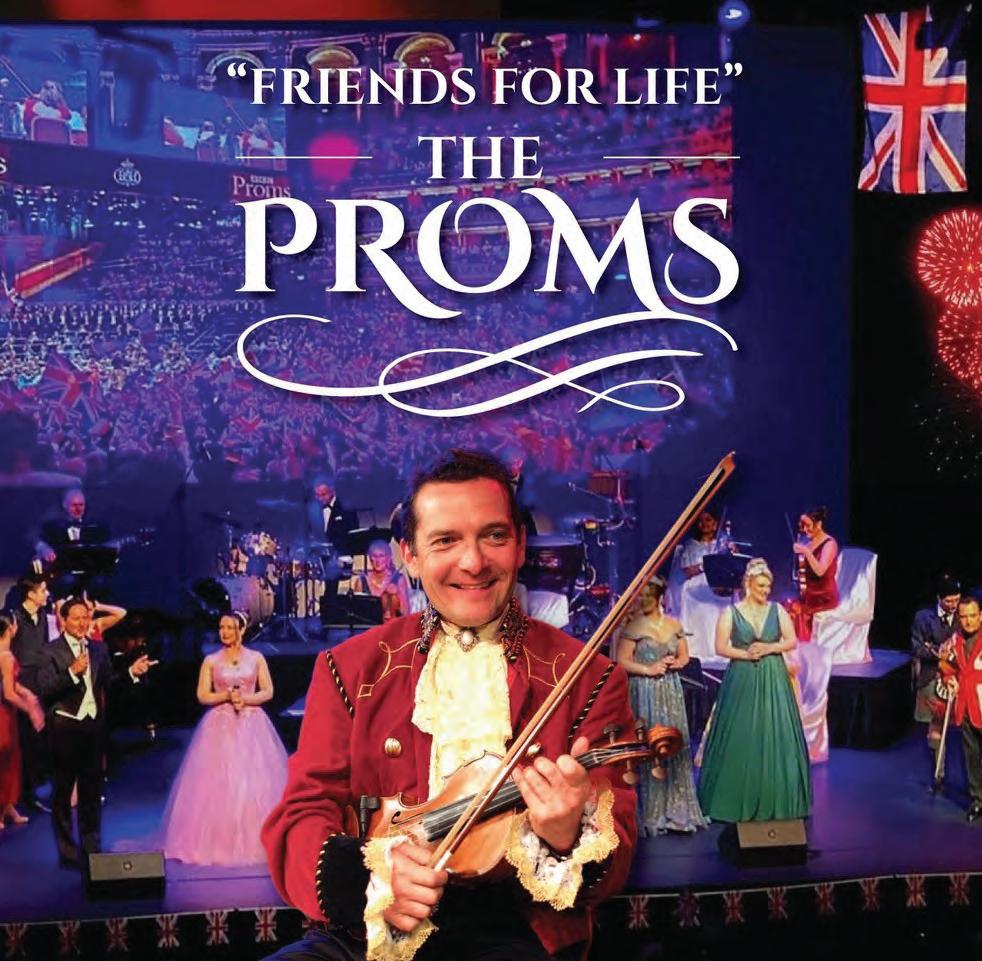


SHIRLEY SINCLAIR heads three hours west for a little flutter on the gee-gees at a quintessential country race meeting.

events held across almost 100 clubs annually – from punter favourites including Burrandowan, Kumbia, Esk, Stanthorpe and Roma, to Birdsville, Rockhampton, Mt Isa and Mount Garnet –you can hit the road and immerse yourself in an authentic sporting and social experience in our rural towns and villages just about any weekend of the year.
That’s exactly what our merry band of seven from Brisbane and the Sunshine Coast decided to do.
Asmall rural township at the foothills of the Bunya Mountains really knows how to ring in the masses for special events throughout the year.
The tiny dot on the map may not seem to have much appeal at first glance on any drive into the Western Downs –Queensland’s ‘Big Sky Country’.
But, like many small country towns, what lies beneath the surface is what is so special about the pretty rural enclave that is Bell.
The proud residents of the township and its surrounds – nearly 40 clicks north of Dalby, in the Wambo Shire – mostly make a living by farming beef cattle, sheep, pigs and grain.
The 500 residents work hard for their life on the land and might have been content to sit back and make their own fun in their downtime.
Instead, the friendly folk of Bell wear several hats as they volunteer to welcome visitors with open arms at a host of social occasions on the annual calendar.
At the time of publication, the most recent was on March 2 and 3, when the Bell Show Society celebrated 65 years of the agricultural show, along with the Show Ball and Showgirl and Rural Ambassador
awards, rodeo and maiden campdraft at the showgrounds.
But the annual Bell Races, held on the first Saturday in January, is a huge crowd-puller and the only on-course meeting in the town each year. Busloads of racegoers and punters of all ages from Dalby, the South Burnett and Brisbane join fashionistas and roadtrippers from near and far for the big day out.
The 2024 instalment on January 6 celebrated 100 years of racing for the Bell Race Club Inc. with more than 2000 through the gates (but when Menindee beat Moscini by the slimmest of margins in Race 6, the 2024 Bell Race Club Centenary Open Plate over 1300m, it felt more like 3000 crowded around our trackside table!).
Judging by the numbers camping on course and taking advantage of campervan and caravan spots, as well as cabins at Bell Tourist Park, most people were making a weekend of it.
And why wouldn’t you, with a six-race program, bar, food vans and a kiosk, foot races, Fashions on the Field, and naming of the Bush Bachelor and Bachelorette, as well as the after-party until late.
Queenslanders love a good country or picnic race meeting.
And with more than 200 non-TAB

What they say about country hospitality being warm and welcoming certainly rings true in Bell.
And it was demonstrated in abundance on the Friday night as we grabbed a drink at the bowls club.
The first friendly face we saw was Bell Tourist Park owner Emilia Wilson – this time taking food orders behind the bar.
Conversations between strangers flowed easily from an initial ‘Where are you from?’, as we sat down at long tables in the hall with our orders of homemade pie, chips, gravy and coleslaw or entertained ourselves (and others) under floodlights with a very dodgy game of barefoot bowls.
We thought we were up early on the Saturday morning, but the pet-friendly


tourist park had long been stirring.
Hot breakfasts at the camp kitchen were on the boil, caravanners and campervan owners were tidying up awnings and annexes, while others enjoyed the birdsong and shade with a coffee on the cabin patios.
A stroll around the empty streets painted the picture of a proud Bell history in colourful murals and memorials, the Bell Station Precinct with its early model diesel locomotive and vintage passenger carriage, and quaint Queenslander homes and the RSL Sub-Branch with well-tended gardens.
The only bustling hub was the general store, already cooking up takeaway orders for the younger set sitting out the front.
But with the racecourse gates open at 10am, we didn’t have long to don our smart racewear, fancy headbands and fascinators, find our spot under a Your Mates Brewing Co-sponsored umbrella, sit back and enjoy the proceedings.
For most of the program, our group needed only to take a few steps forward for an uninterrupted view of the horses bounding down the straight – so close, we wore some of the dust kicked up by the closest gallopers.
For Race 4, The Gordon Family QTIS Maiden Plate 100m, the crowd started milling around us early, quickly blocking any chance of seeing the runners.
So, I stayed in my seat, allowing the crowd’s voices to pick me up and carry me along for the ride.
The cheers rang out, building to a euphoria in sync with the thunderous pounding adjacent to me as the pack took the final outstretched strides towards the finish line.
A goosebumps moment.
Make sure you save the date next year – Saturday, January 4 – when Bell will once again resonate with punters and travellers wanting a great day at the races. Visit bellraces.com
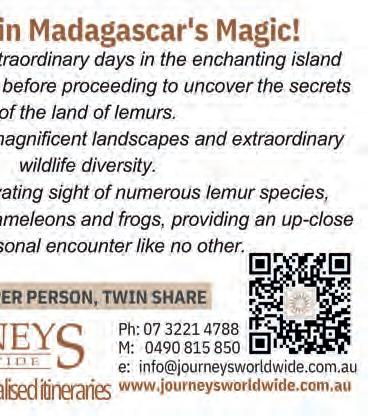
EVERY year, one of the most remarkable events in the natural world unfolds in the vast plains of the Serengeti.
The Great Wildebeest and Zebra Migration is a spectacle of epic proportions that captivates seasoned travellers and nature enthusiasts alike.
As these vast herds traverse the rugged terrain, they embark on a journey fraught with challenges and dangers, yet filled with moments of awe-inspiring beauty. The migration is a constant process – as the vast herds constantly search out food sources. As they follow the rains, they complete a clockwise circle: from the vast short-grass plains of the southern Serengeti to the Mara in the north.
You might say that it starts in the south – for that is when the herds spread out.
Over a short three-to-fourweek period, nearly a million babies join the herds. The sudden glut of easy prey is too much for the hungry predators and allows a greater proportion of survivors, as the youngsters gain in strength rapidly.
A wildebeest mother can stop
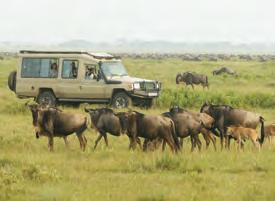
the birth process at any time up until the head is out and still be swift enough to evade predators.
The youngsters will immediately start attempting to get mobile and in as little as seven minutes after being born, will be mobile and able to keep up with their mother. This is my favourite time and I try to make it an annual pilgrimage to view the calving period.
But what more often captures the attention of the outside world are the dramatic river crossings in the north, where hundreds of thousands of wildebeest and zebra brave swift currents and lurking predators in a bid to reach greener pastures.
By Sean Lues,managing director and safari guide at Journeys Worldwide. Visit journeysworldwide. com.au or call 3221 4788.

Thursday 21st March
Thursday 18th April
IN THE middle of a wide fjord, the ship switches off its engines and slows to a stop as playful whales cross just metres ahead.
Everyone watches in awe as the duo dances in the water, rolling in circles and slapping the water with their fins.
Jennifer, a usually shy and quiet 32-year-old, is excited.
“I’ve never seen whales do this before,” she says. “It’s like they’re waving.”
This is Jennifer’s 17th voyage with Hurtigruten, but it’s clear that the joy she feels for the Norwegian coast remains as deep and strong as it was on her first voyage. That was six years ago and taken under difficult circumstances: “To be told at 26 years old that you have brain cancer…”
Jennifer decided that she needed to start doing all the things she had always wanted to do but had put off. The Northern Lights – nature’s magical light show – are still the main reason she sails with Hurtigruten between October and March.
Contact your local Travellers Choice agent to book.
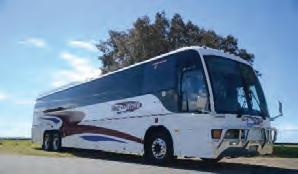

WOODFORD – BRISBANE VALLEY LAKES – ESK
Thursday
May
Saturday
Red and White Coaches
PH: 3269 6466
Email: info@redandwhitecoaches.com.au
www.redandwhitecoaches.com.au
CT TRAVEL’S Paul Brockhurst is an expert in touring Australia by coach and shares the top 5 reasons you should book a tour.
1. Everything is organised for you: on a CT Travel coach tour, you don’t need to do a thing other than sit back and enjoy the ride.
2. Experience the best tours and attractions: with our first-hand knowledge, we have designed itineraries that incorporate the best tours and attractions and ensure you don’t miss a thing.
3. Explore our magnificent
country: Australia is a land of contrasts and right now is the best time to get out and immerse yourself in our own backyard.
4. Tour with comfort and ease: our air-conditioned coaches have panoramic windows, plenty of legroom and an onboard toilet.
5. Enjoy the company of like-minded travellers: like you, theyenjoy the comfort and hassle-free experience of exploring by coach.
Visit cttravel.com.au or call 5391 1648.
Trollstigen, or ‘Troll’s Road’ is an engineering feat in the Westland region and one of the most-visited tourist roads in Norway. The route stretches for 106 km and is a narrow serpentine highway, part of the Norwegian County Road 63. It lies in the area of Rauma in Romsdal, with 11 sharp turns. While the observation deck’s view is spectacular in itself, nothing beats driving along the road (only 3.3m wide in parts) – complete with waterfalls. If you have a gob-smacking photo from your holidays, send it in with details for consideration in our travel pages. Email editor@ yourtimemagazine.com.au



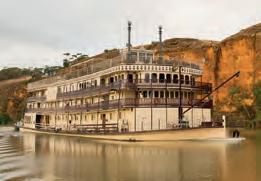



APRIL
Great
MAY



Carnarvon George & Wallaroo (7
Vivid Lights Festival Sydney (8
JUNE
Qld Outback to Coast (12 Days)
Tropical Nth Qld (8 Days)
Nth Qld Savannah Way (11 Days)
JULY
Nth Qld Savannah Way
Lightning Ridge (7 Days)
Mystery Escape (4 Days)
Christmas in July (1 Day Trip)
AUGUST
Lightning Ridge
Carnarvon Gorge & Wallaroo (7 Days)
Cobb & Co 100 Year Celebration – Toowoomba (3 Days)
SEPTEMBER
Carnarvon Gorge & Wallaroo (7 Days)
SEPTEMBER 2023
K’gari (Fraser Island) Whale Watch (4 Days)
Carnarvon
Toowoomba Carnival of Flowers (4 Days)
Toowoomba
Spring Gardens (10 Days)
Spring
October,
NOVEMBER Tasmania (14 Days)
O’Reillys (4 Days)









There’s never been a better time to see Norway with its wild coastline, perfect for adventure all year round.
as you sail along the coast, surrounded by the dramatic colours of the aurora display.
Uncover Norway’s stunning fjords, mountains, cities and charming towns on a cruise that crosses the Arctic Circle twice, venturing along both north and southbound routes.
Highlights: Bergen • Ålesund • Trondheim • Bodø • Tromsø
• Honningsvåg • Kirkenes • Hammerfest • Svolvær • Brønnøysund
Departs 26 October 2024
12 days from $3,094*pp


Combine an Arctic adventure on a coastal round trip voyage with a land, rail and sea tour exploring the stunning mountain and fjord scenery between Oslo and Bergen.
Highlights: Oslo • Flåm • Voss • Bergen • Ålesund • Trondheim • Bodø
• Honningsvåg • Kirkenes • Hammerfest • Svolvær • Brønnøysund
Departs 22 October 2024

16 days from $4,799*pp SAVE
Experience the enchanting Finnish Lapland and Norwegian coastal towns on an escorted small-group tour from Stockholm to Bergen while following the midnight sun.
Highlights: Stockholm • Helsinki • Rovaniemi • Saariselkä • Kirkenes
• Hammerfest • Svolvær • Brønnøysund • Trondheim • Bergen
Departs 4 July 2024
15 days from $7,598*pp
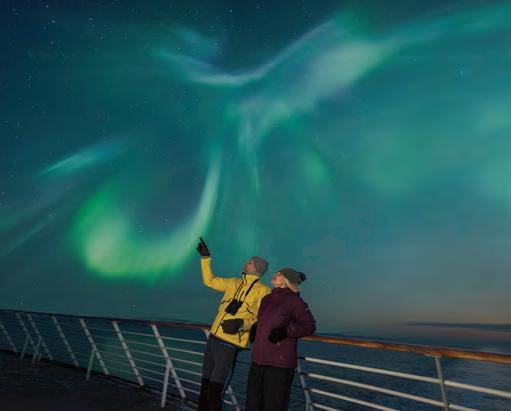





Reviewed by Jan Kent
THE latest offering from Australia’s masterful crime writer does not disappoint, whether or not you are as big a fan of Chris Hammer as I am.
Within the setting of a small western New South Wales town –brought to life so vividly you could just about feel the grit in the air – is the discovery of a murder victim, connected to one of the seven families who have dominated the district’s life for generations.
Weaving the many threads of the tale, spanning three distinct time frames, twisting and turning, with nothing as it seems, Hammer grips the reader from the outset and cleverly maintains the intrigue to the unexpected conclusion.
Basing the story around real events – in this case, World War I and the Murrumbidgee Irrigation Project –lends authenticity and contributes to the success of the latest novel from one of Australia’s finest crime writers.

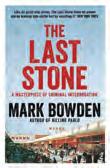
 By Mark Bowden
By Mark Bowden
True crime
Reviewed by John
KleinschmidtIN 1975, two young sisters, aged 10 and 12, went missing from a shopping mall in Washington.
Investigations over the next decades led nowhere and searches ceased.
In 2013, detectives unearthed the first real lead in the case and started questioning Lloyd Welch: a man who had been in the mall that day and reported seeing another man take the girls.
Detectives discovered that Welch had been involved in numerous crimes, including child molestation in the intervening decades.
The author focuses on 21 months of questioning Welch by many detectives, befriending and setting up the master liar.
Clever strategy and interrogations eventually pry out the truth.
The Last Stone provides an intriguing look at a complex police investigation, even if it can be a little slow in parts.
Reviewed by Annie Grossman.
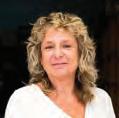
SEX, drugs and alcohol. No, this is not the memoir of a rockstar, although if you opened the book midway and started reading, you’d be forgiven for thinking so.
It’s the true, sometimes hilarious, oftenshocking story of a regular woman – a wife, a mother – whose first foray into boozing began at the tender age of 11 and continued until her time of reckoning almost three decades later.
Victoria Vanstone, the creator of the Sober
Awkward comedy podcast, doesn’t hold back.
Some might feel she overshares (she apologises to her parents at the end of the book for having to read about the adventures of her vagina), but you just know this raw honesty and full transparency will cut through to readers struggling with similar issues.
Here is a woman who grew up in a happy home, but would later find herself resorting to pregnancy as a way to stop drinking. As serious as her story of partying, parenting and achieving sobriety is, Vanstone maintains her humour throughout. A sobering yarn that will strike a chord with anyone who has an unhealthy relationship with alcohol.

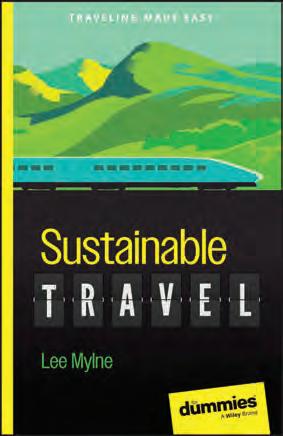
DR LEE Mylne has built up plenty of cred in tourism and travel.
She’s spent more than three decades writing about the topics for magazines, newspapers, digital and online publications, and is the author or co-author of about a dozen guide books, including Australia For Dummies (2008).
Born a Kiwi, Mylne has lived in six countries on four continents but is a long-time resident of Australia, now calling Brisbane home. She’s been travelling the world for most of her adult life.
In her latest two ‘Dummies’ resource books, she opens readers’ eyes to new considerations in the way we travel as we broaden our horizons, post-pandemic.
Solo Travel for Dummies is Mylne’s lived experience that will help everyone from seasoned explorers to nervous first-timers choose a destination, plan a fulfilling itinerary, save money and stay safe by
by Lee Mylne.providing must-have info, insider tricks and essential checklists. There’s even tips on how to avoid loneliness and what to do if you get lost.
Similarly, she understands that sustainability is no longer just a catchphrase or slogan but an important consideration for a growing number of travellers of all ages and budgets who want to reduce their carbon footprints, respect and protect the planet, contribute to local economies and incorporate conservation into their travel experiences.
Sustainable Travel For Dummies is an easy-to-read guide that explains the concept, why it’s so important, and how to do it by looking at ecofriendly destinations, alternative transportation, unique accommodation and fulfilling cultural experiences. If nothing else, this book will get you thinking more about how and why you travel, and how you can leave a positive impact on the places you visit.


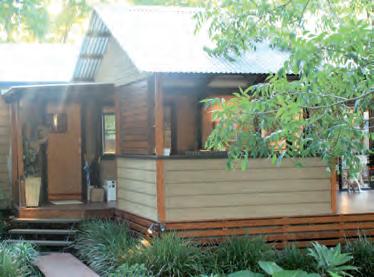

1. What colour in the Olympic rings is not visible in a rainbow?
2. What part of a human body is treated by a dermatologist?
3. In which US state is Chicago?
4. What is the collective noun for a group of baboons?
5. Complete the proverb: “A closed mouth catches no ...”
6. What is the first given name of ‘Molly’ Meldrum?
7. What film is credited as being the highest-grossing Australian movie?
8. What kind of living thing is a remora?
9. What is the traditional gift for a first wedding anniversary?
10. What country produces the most maize?
11. Which capital city is closest to Sydney: Wellington in New Zealand, Darwin or Perth?
12. What was the occupation of the title character in the novella Goodbye, Mr Chips?
13. Used in reference to time, what does the ‘M’ stand for in the abbreviation GMT?
14. In the board game Scrabble, how many tiles are worth 10 points?
15. What household item can be shag pile or twist pile?
16. What is the English equivalent of the German word ‘Montag’?
17. What book of the Bible was also a band fronted by Phil Collins?
18. For what recipe was Flo Bjelke-Petersen renowned?
19. When is a valedictory speech given?
20. How many seconds are between midnight and 6am?

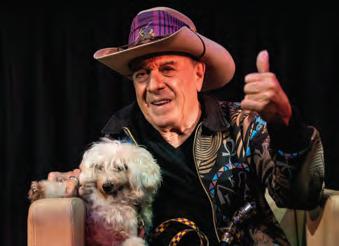














Across
1 Hitler’s bodyguard, bound by decree, reformed and broke up(8)
5 Jeer short, battling club basketball player(6)
9 Old coin coloured in the middle(7)
10
11 So, senior MP corrected a slip of the tongue?(10)
12 Animal, with tail cut off, drew near(4)
13 Head of security makes a recording with listening device(6)
14 Reformed model that is starting to sing songs(8)
17 Hullabaloo made about a tree and Queensland
18 Head of college accommodating company
21 Start to smooth and polish with abrasive material(4)
22 Dodgy tailor has brought around hot Hawaiian
24 Fishing vessel left in water churned by river(7)
25 A hundred runs, for example, scored before duck in a single
26 Cute minor claiming right(6)
27 Barbaric people cook chickens(8)
Down
1 Cold is contracted by strike-breakers and prejudiced people(7)
2 Occasional tenor botched battle for minor places in competition(11,4)
3 Cord attached to twisted net is tight(9)
4 Stand under damaged stern of frigate(6)
6 Dog without lead jumped obstacle(4)
7 Fellow, insincere, had misconstrued language(8,7)
8 They knock funky musicians(7)
10 Nut case pruned with axe!(6)
15 Drive away in public and go too far(9)
16 Therapist that girl injected with alcohol(6)
17 New version of DOS kept for computer(7)
19 Fancies last piece of meat smothered in cooked onions(7)
20 The stunted people in a region of SE Europe(6)
23 Mark front of boxed set(4)




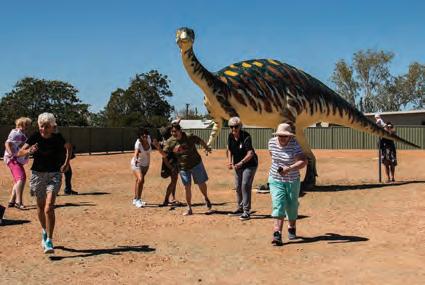

24
ACROSS
1 Mortarboard(3)
3 English poet and playwright(11)
9 Having more leaves(7)
10 Country(7)
11 Allowing(8)
12 Sensual(6)
14 Gain possession(3)
15 Instructive(11)
17 Deporting(11)
19 Fellows(3)
20 Actor, – Brie(6)
21 One of the Caribbean islands(8)
24 Merit(7)
25 A state in 10-across(7)
26 Persistently(11)
27 Spot(3)
DOWN
1 Co-worker(9)
2 Poor labourer of low social status(7)
3 Aptitude(5)
4 Dealing with the operation of aircraft(10)
5 Web auction site(4)
6 Readying for use(9)
7 City in southern France(7)
8 Cyber messages(5)
13 One who uses their wealth to invest in trade and industry(10)
15 Feeling a strong affection(9)
16 Visible features of an area(9)
18 City in northern Italy(7)
19 Occupying a middle position(7)
20 Seconds(5)
22 Pal(5)
23 million(4)




























-

- An economical and safe way to heat the home.
- Works as a dehumidifier by removing
- A space saver being out of the way up on the wall.
- Circulates air throughout the room with a DC invertor technology making more energy efficient.





































